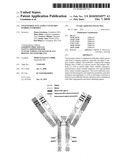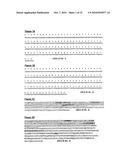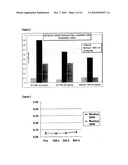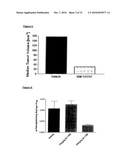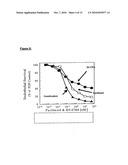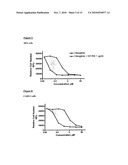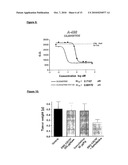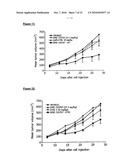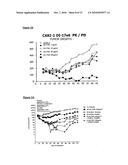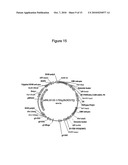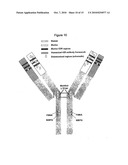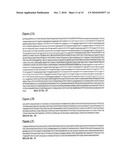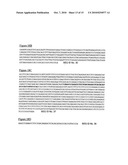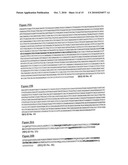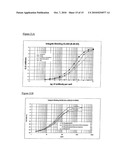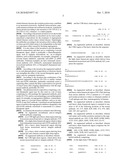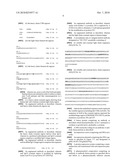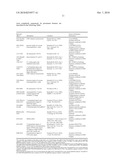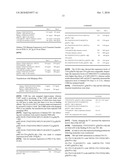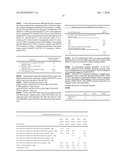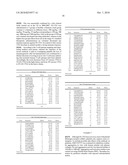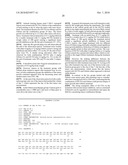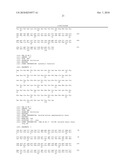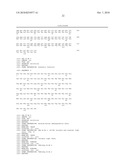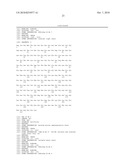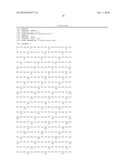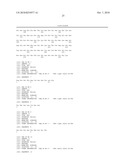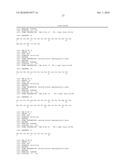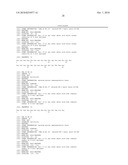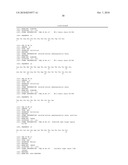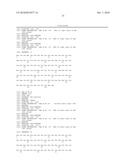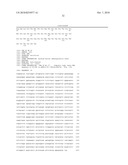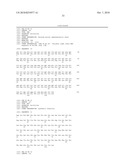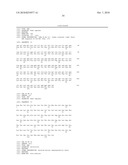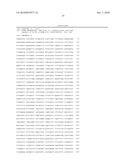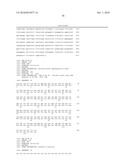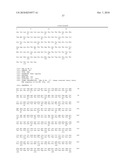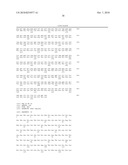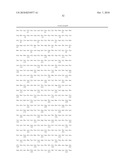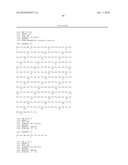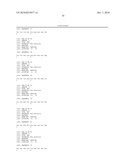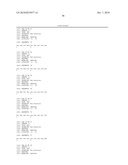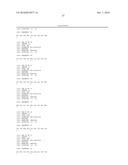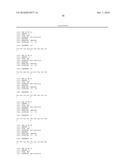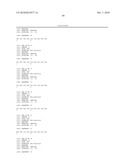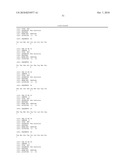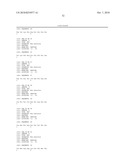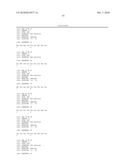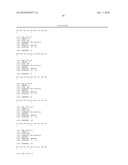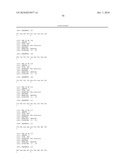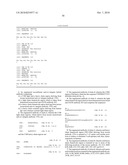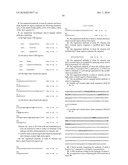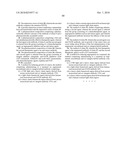Patent application title: ENGINEERED ANTI-ALPHA V-INTEGRIN HYBRID ANTIBODIES
Inventors:
Simon Goodman (Griesheim, DE)
Simon Goodman (Griesheim, DE)
Diane Hahn (Seeheim-Jugenheim, DE)
Francesc Mitjans (Igualada, ES)
Jaume Adan (Mataro, ES)
Kin-Ming Lo (Lexington, MA, US)
Assignees:
Merck Patent GmbH
IPC8 Class: AC07K1618FI
USPC Class:
4241331
Class name: Drug, bio-affecting and body treating compositions immunoglobulin, antiserum, antibody, or antibody fragment, except conjugate or complex of the same with nonimmunoglobulin material structurally-modified antibody, immunoglobulin, or fragment thereof (e.g., chimeric, humanized, cdr-grafted, mutated, etc.)
Publication date: 2010-10-07
Patent application number: 20100254977
Claims:
1. An engineered recombinant anti-.alpha.v-integrin hybrid antibody
comprising:(i) a CDR light and a heavy chain region deriving from mouse
monoclonal anti-.alpha.v integrin antibody 17E6;(ii) a light chain
framework region which is taken from humanized monoclonal anti-EGFR
antibody 425;(iii) a heavy chain framework region deriving from mouse
monoclonal anti-.alpha.v integrin antibody 17E6; and(iv) a heavy chain
constant region deriving from human IgG and a human constant light chain
region.
2. The engineered antibody of claim 1, wherein the CDR light chain regions, which derive from mouse monoclonal anti-.alpha.v integrin antibody 17E6, are: TABLE-US-00035 CDR1: RASQDISNYLA, (SEQ ID No. 5) CDR2: YTSKIHS, (SEQ ID No. 6)[[;]] and CDR3: QQGNTFPYT, (SEQ ID No. 7)
and the CDR heavy chain regions are: TABLE-US-00036 (SEQ ID No. 8) CDR1: SFWMH, (SEQ ID No. 11) CDR2: YINPRSGYTE (X) NEIFRD, wherein X = C or Y, and (SEQ ID No. 10) CDR3: FLGRGAMDY.
3. The engineered antibody of claim 2, wherein the CDR2 region of the heavy chain has the sequence YINPRSGYTEYNEIFRD (SEQ ID No. 9).
4. The engineered antibody of claim 1, wherein the light chain framework region derives from humanized monoclonal anti-EGFR antibody 425 and comprises the sequences TABLE-US-00037 FR-1: DIQMTQSPSSLSASVGDRVTITC, (SEQ ID No. 12) FR-2: WYQQKPGKAPKLLIY, (SEQ ID No. 13) FR-3: GVPSRFSGSGSGTDYTFTISSLQPEDIATYYC (SEQ ID No. 14) and FR-4: FGQGTKVEIK. (SEQ ID No. 15)
5. The engineered antibody of claim 1, wherein said heavy chain framework region (FR1-FR4) deriving from mouse antibody 17E6 is mutated at 1-15 amino acid residue positions to reduce or eliminate T-cell epitopes and, thus, immunogenicity in humans.
6. The engineered antibody of claim 5, wherein said heavy chain framework region is mutated at one or more of the following positions of the mouse antibody: A9, E13, M20, K38, R40, A72, S76, Q82, G85, T87, S91 and S113.
7. The engineered antibody of claim 6, wherein said amino acid residue positions mutated in the engineered antibody are: A9G, E13K, M20V, K38R, R40A, A72T, S76T, Q82E, G85S, T87R, S91T, S113T.
8. The engineered antibody of claim 5, wherein said heavy chain framework region comprises the following mutations: A9G, E13K, M20V, K38R, R40A, A72T, S76T, Q82E, G85S, T87R, S91T and S113T.
9. An engineered recombinant anti-.alpha.v-integrin hybrid antibody comprising(i) the light chain CDR regions: TABLE-US-00038 CDR1: RASQDISNYLA; (SEQ ID No. 5) CDR2: YTSKIHS; (SEQ ID No. 6) CDR3: QQGNTFPYT, (SEQ ID No. 7)
(ii) the heavy chain CDR regions: TABLE-US-00039 CDR1: SFWMH, (SEQ ID No. 8) CDR2: YINPRSGYTEYNEIFRD, (SEQ ID No. 9) and CDR3: FLGRGAMDY; (SEQ ID No. 10)
(iii) the light chain framework regions: TABLE-US-00040 FR-1: DIQMTQSPSSLSASVGDRVTITC, (SEQ ID No. 12) FR-2: WYQQKPGKAPKLLIY (SEQ ID No. 13) FR-3: GVPSRFSGSGSGTDYTFTISSLQPEDIATYYC (SEQ ID No. 14) FR-4: FGQGTKVEIK (SEQ ID No. 15)
(iv) the heavy chain framework regions TABLE-US-00041 FR1: QVQLQQSGAELAEPGASVKMSCKASGYTFS (SEQ ID No. 16) FR2: WVKQRPGQGLEWIG (SEQ ID No. 17) FR3: KATMTADTSSSTAYMQLSGLTSEDSAVYYCAS (SEQ ID No. 18) FR4: WGQGTSVTVSS, (SEQ ID No. 19)
wherein one, more or all of the bold and underlined positions are mutated in order to reduce or eliminate T-cell epitopes and thus immunogenicity in a human, and(v) a heavy chain constant region deriving from human IgG and a human constant light chain region.
10. The engineered antibody of claim 9, wherein said heavy chain framework regions are: TABLE-US-00042 FR1: QVQLQQSGGELAKPGASVKVSCKASGYTFS (SEQ ID No. 20) FR2: WVRQAPGQGLEWIG (SEQ ID No. 21) FR3: KATMTTDTSTSTAYMELSSLRSEDTAVYYCAS (SEQ ID No. 22) FR4: WGQGTTVTVSS. (SEQ ID No. 23)
11. The engineered antibody of claim 1, wherein the heavy chain constant region derives from IgG2.
12. The engineered antibody of claim 11, wherein said IgG2 constant region comprises a modified IgG1 hinge region.
13. The engineered antibody of claim 12, wherein said modified IgG1 hinge region comprises the sequence TABLE-US-00043 EPKSSDKTHTCPPCP. (SEQ ID No. 24)
14. The engineered antibody of claim 11, wherein said IgG2 constant region is modified by replacing amino acid N with Q at position 297 (N297Q).
15. The engineered antibody of claim 14, wherein amino acid residue F at position 296 is replaced by A (F296A) in order to eliminate a T-cell epitope generated by the modification at position 297.
16. The engineered antibody of claim 1, wherein and the light chain constant region is human kappa.
17. The recombinant anti-.alpha.v-integrin hybrid antibody of claim 1 comprising(i) variable and constant light chain sequences (SEQ ID No. 3): TABLE-US-00044 DIQMTQSPSSLSASVGDRVTITCRASQDISNYLAWYQQKPGKAPKLLIYY TSKIHSGVPSRFSGSGSGTDYTFTISSLQPEDIATYYCQQGNTFPYTFGQ GTKVEIKRTVAAPSVFIFPPSDEQLKSGTASVVCLLNNFYPREAKVQWKV DNALQSGNSQESVTEQDSKDSTYSLSSTLTLSKADYEKHKVYACEVTHQG LSSPVTKSFNRGEC and
(ii) variable and constant heavy chain sequences (SEQ ID No. 4): TABLE-US-00045 QVQLQQSGGELAKPGASVKVSCKASGYTFSSFWMHWVRQAPGQGLEWIGY INPRSGYTEYNEIFRDKATMTTDTSTSTAYMELSSLRSEDTAVYYCASFL GRGAMDYWGQGTTVTVSSASTKGPSVFPLAPCSRSTSESTAALGCLVKDY FPEPVTVSWNSGALTSGVHTFPAVLQSSGLYSLSSVVTVPSSNFGTQTYT CNVDHKPSNTKVDKTVEPKSSDKTHTCPPCPAPPVAGPSVFLFPPKPKDT LMISRTPEVTCVVVDVSHEDPEVQFNWYVDGVEVHNAKTKPREEQAQSTF RVVSVLTVVHQDWLNGKEYKCKVSNKGLPAPIEKTISKTKGQPREPQVYT LPPSREEMTKNQVSLTCLVKGFYPSDIAVEWESNGQPENNYKTTPPMLDS DGSFFLYSKLTVDKSRWQQGNVFSCSVMHEALHNHYTQKSLSLSPGK.
18. A fusion protein comprising the antibody of claim 1 fused at its C-terminal to a cytokine or growth factor.
19. A DNA molecule coding for the antibody of claim 1.
20. An expression vector comprising the DNA molecule of claim 19.
21. The expression vector of claim 20, wherein the encoded antibody comprises the mutation N297Q.
22. A protein expression system comprising a mammalian host cell transformed with the expression vector of claim 21.
23. A pharmaceutical composition comprising a pharmaceutically effective amount of the antibody of claim 1 and a pharmaceutically acceptable carrier.
24. A pharmaceutical composition comprising a first and second pharmaceutically effective therapeutic agent, wherein the first agent is the antibody of claim 1, and the second agent is selected from the group consisting of: a chemotherapeutic agent, an angiogenesis inhibitor and an anti-tumor agent.
25. The pharmaceutical composition of claim 24, wherein the second therapeutic agent is an anti-tumor antibody.
26. The pharmaceutical composition of claim 24, wherein said second agent is selected from the group consisting of integrin inhibitor cilengitide, anti-EGFR inhibitors mAb c225 (cetuximab, Erbitux®) and mAb h425 (matuzumab), and chemotherapeutic agents cisplatin and DTIC.
27-30. (canceled)
31. A method for reducing growth of a tumor, the method comprising administering to a mammal an engineered, recombinant anti-.alpha.v-integrin hybrid antibody comprising:(i) a CDR light and a heavy chain region derived from mouse monoclonal anti-.alpha.v integrin antibody 17E6(ii) a light chain framework region derived from humanized monoclonal anti-EGFR antibody 425,(iii) a heavy chain framework region derived from mouse monoclonal anti-.alpha.v integrin antibody 17E6, and(iv) a heavy chain constant region derived from human IgG and a human constant light chain region.
32. The method of claim 31, further comprising administering a second agent, wherein the second agent is selected from the group consisting of a chemotherapeutic agent, an angiogenesis inhibitor and an anti-tumor agent, and wherein the engineered antibody increases the efficacy of the second agent.
33. The method of claim 32, wherein the second agent is an anti-EGFR antibody, and re-growth of the tumor does not occur within about 40 days of the last administration of the engineered, recombinant anti-.alpha.v-integrin hybrid antibody.
34. The method of claim 33, wherein the first therapeutic agent is the engineered antibody of claim 17, and the second therapeutic agent is mAb c225 (cetuximab).
35. A method for reducing angiogenesis in a mammal, the method comprising administering to a mammal an engineered, recombinant anti-.alpha.v-integrin hybrid antibody comprising(i) a CDR light and a heavy chain region derived from mouse monoclonal anti-.alpha.v integrin antibody 17E6(ii) a light chain framework region derived from humanized monoclonal anti-EGFR antibody 425,(iii) a heavy chain framework region derived from mouse monoclonal anti-.alpha.v integrin antibody 17E6, and(iv) a heavy chain constant region derived from human IgG and a human constant light chain region.
Description:
FIELD OF THE INVENTION
[0001]The invention relates to engineered antibodies which specifically bind to integrin receptors, especially the alpha V integrin receptor subunit. The antibodies comprise the antigen binding sites (CDRs) of a known mouse anti-integrin antibody, as well as hybrid light chain variable sequences, mutated heavy chain variable sequences (Frs) and modified heavy chain constant sequences. The novel antibodies have improved immunogenic and expression properties and elicit excellent anti-angiogenic as well as anti-tumor activities in humans in monotherapy but also and above all in combination with other angiogenesis and tumor inhibiting agents, such as cilengitide, cetuximab and chemotherapeutic agents.
BACKGROUND OF THE INVENTION
[0002]Treatment of cancer remains a major problem in health care. One proposed strategy for treatment of cancer is inhibition of angiogenesis and thus inhibiting the generation and development of blood vessels, which supply the tumor with growth relevant means. A second strategy is direct inhibition of specific receptors on tumor cell surfaces, such as the inhibition of Her2 by Herceptin® or inhibition of EGFR by cetuximab (Erbitux®).
[0003]Inhibitors of integrins are considered to be potentially useful anti-tumor agents, because integrins are expressed on tumor neovasculature and mediate angiogenesis. In addition, integrins are expressed on certain tumor cells and may directly promote tumor growth and survival.
[0004]Integrins have no enzymatic activity, but integrins capable of binding their ligands (ligand-competent integrins) are activated by binding to proteins of the ECM. Integrins on one hand trigger intracellular kinase cascades to modulate cell growth and survival, and on the other associate with the cytoskeleton to drive cell attachment and locomotion. αvβ5 integrin specifically binds vitronectin, while αvβ3 also binds other macromolecules of the provisional ECM. αvβ3 was first noted in cancer as a progression-dependent marker on malignant melanoma. It enhanced melanoma growth in vivo and survival in vitro. αvβ3 blockers reversed these effects. Subsequently, αvβ3 was found in other tumors including glioblastoma, renal carcinomas, ovarian carcinomas and others. αvβ3 was also widely over-expressed in the ECs in many malignancies. In vitro, angiogenic models activated by tumor-derived growth factors over-expressed and required αvβ3 on the sprouting vasculature, while αvβ3 and αvβ5 blockade could suppress the angiogenic phenotype. αvβ5 was also shown to support the neo-vasculature induced by some tumor-derived growth factors. Inhibiting αvβ5 can trigger apoptosis of tumor cells.
[0005]The integrin receptors are over-expressed on tumor invasive blood vessels, on melanomas and some other malignancies, and modulate cellular response to growth factors. The vascular compartment is a promising therapeutic target because solid tumors depends on blood vessels for oxygen, nutrition, detoxification and the dispersion of blood borne metastases; the switch to the angiogenic phenotype marks a discrete step in the induction of malignancy, which is amenable to therapeutic intervention; and the vasculature undergoes continuous change, yet endothelial cells have genomic stability relative to the tumor, and are less likely to become drug-resistant through mutation.
[0006]A first anti-integrin drug is cilengitide and is considered to be a useful antitumor agent (Eskens F A, et al. (2003) Eur J Cancer 39:917-26). However, cilengitide is a small molecule that must be dosed frequently. The structure of cilengitide; selected salt form e.g. are disclosed in EP0770622, WO 0015244 and PCT/us07/01446 and are disclosed herein by reference.
[0007]A second anti-integrin drug is mouse mAb 17E6 (EMD 73034), that inhibits specifically the αv integrin subunit of human integrin receptor bearing cells. The mouse IgG1 antibody is described, for example by Mitjans et al. (1995; J. Cell Sci. 108, 2825) and U.S. Pat. No. 5,985,278 and EP 719 859. The complete variable heavy and light chain sequences are depicted in SEQ ID Nos. 25 and 26 (FIGS. 20 A, B). Murine 17E6 was generated from mice immunized with purified and Sepharose-immobilized human αvβ3. Spleen lymphocytes from immunized mice were fused with murine myeloma cells and one of the resulting hybridoma clones produced monoclonal antibody 17E6 (EMD 73034). Mouse mAb 17E6 is produced by hybridoma cell line 272-17E6 and deposited under accession number DSM ACC2160.
[0008]Mouse 17E6 antagonizes integrin interaction with the extracellular matrix (ECM), and perturbs the function of endothelial and tumor cells. Primary effects of the antibody include disrupting endothelial cell (EC) adhesion and movement, inducing their apoptosis, and suppressing the activation of growth factor pathways. Blockade by said antibody directly suppresses survival of both the activated endothelial cells and some tumor cells.
[0009]Monoclonal antibodies such as 17E6 are generally useful for the inhibition of extracellular protein-protein interactions, such as the inhibition of ligand-receptor interactions. However, monoclonal antibodies are often difficult to express and often provoke an immune response, such as an anti-idiotypic response, which limits their effectiveness.
[0010]These data and principal knowledge gathered so far supported the need of development of a modified mouse 17E6 antibody with improved properties that binds specifically to integrins, can be efficiently expressed, and is relatively non-immunogenic in humans as a therapeutic agent in cancer. Such an engineered antibody should have the potential to suppress the development of the tumor both indirectly, via the tumor vasculature, and directly on the tumor cells themselves.
SUMMARY OF THE INVENTION
[0011]The invention relates to new antibodies having the biological characteristics of monoclonal mouse antibody 17E6 (EMD 73034) but with improved properties above all with respect to immunogenicity in humans and satisfying expression in mammalian expression systems in an industrial production and manufacturing scale.
[0012]The invention provides a few engineered antibodies having modified sequences, which recognize the same receptor epitope as mouse antibody 17E6 but show reduced immunogenicity in humans and can be better expressed as the comparable non-modified antibody.
[0013]It should be noted that modifying or engineering a mouse derived antibody in order to obtain reduced immunogenicity in humans is, as a rule, accompanied by a distinct loss of expression and/or binding affinity. Thus, chimerization or humanization according to well known standard techniques usually leads to a decrease of expression, binding affinity etc., which can only partially resolved by specific back mutations or other measures. Modifications within a respective protein molecule that are simultaneously successful with respect to reduced immunogenicity, high expression and satisfying binding affinity cannot be predicted. Thus, decreasing the number of T-cell epitopes in order to eliminate or reduce an immune response against the drug in a human as primary problem to be solved, may lead to non-tolerable loss of expression or binding affinity or both that would lead to further problems to be solved.
[0014]It is therefore object of the current invention to provide engineered antibodies with a defined target specificity that elicit reduced immunogenicity, satisfying expression and good binding affinity. These properties can be obtained by surprising modifications within the original source molecule mouse mAb 17E6. In many of the experiments it makes sense to compare the results not directly with the mouse 17E6 antibody but with a chimeric 17E6 version (containing human constant regions). Successful chimeric antibodies of the art, as a rule, show sufficient binding affinity and sufficient expression, but elicit often an immunogenic response in a human individual.
[0015]In principal, the invention provides engineered recombinant anti-αv-integrin hybrid antibodies with reduced or eliminated immunogenicity in humans comprising [0016](i) a CDR light and a heavy chain region deriving from mouse monoclonal anti-αv integrin antibody 17E6 [0017](ii) a light chain framework region which is taken from humanized monoclonal anti-EGFR antibody 425, [0018](iii) a heavy chain framework region deriving from mouse monoclonal anti-αv integrin antibody 17E6, and [0019](iv) a heavy chain constant region deriving from human IgG and a human constant light chain region.
[0020]Humanized monoclonal antibody 425 (matuzumab) is known, for example from EP 531 472, and derives from its murine counterpart 425 (mouse MAb 425, ATCC HB9629), The antibody was raised against the human A431 carcinoma cell line and found to bind to a polypeptide epitope on the external domain of the human epidermal growth factor receptor (EGFR). It was found to inhibit the binding of epidermal growth factor (EGF) at both low and high affinity EGFR sites. Matuzumab has shown in clinical trials high efficacy. The FR sequences of the light chain of matuzumab are depicted in SEQ ID Nos. 12-15 as specified below and in the claims.
[0021]Combining modified heavy chain framework (FRs) regions from anti-integrin mouse antibody 17E6 with light chain frame work regions of a differently specific humanized anti-EGFR antibody h425 (matuzumab) has generated--apart from other modification--some antibodies with superior immunogenic properties, which are furthermore sufficiently expressed in standard mammalian expression systems. Using the VL region (FRs) from mAb h425 surprisingly the expression level is distinctly increased, but, as shown later, further mutations had to be done in order to improve other properties, above all, binding affinity.
[0022]A further important modification is the replacement of an amino acid residue within the CDR2 region of the heavy chain of mouse 17E6. By replacing a cysteine residue by a tyrosine residue surprisingly protein stability and expression level can be distinctly improved at least compared to a chimeric 17E6 version.
[0023]Further improvements in expression and stability can be obtained by replacing the original mouse IgG1 heavy chain constant region by a human IgG2 with a modified human IgG1 hinge region. In a preferred embodiment said IgG2 can be further modified by replacing an ariginine residue at position 297 by an glutamine (N297Q). This modification eliminates an N-glycosylation site and thus abolishes or reduces ADCC and CDC activity of the antibodies to be engineered. Unfortunately, by this measure, the immunogenicity increases, apparently by generation a new T-cell epitope. Surprisingly, by replacing a phenylalanine by alanine at position 296, less immunogenicity can be restored.
[0024]In order to reduce the number of T-cell epitopes in the original heavy chain framework region of mouse mAb17E6 numerous mutations have been carried out. In detail, mutations at one, more or all of the following positions of the mouse antibody: A9, E13, M20, K38, R40, A72, S76, Q82, G85, T87, S91 and S113 are necessary to reduce immunonogenicity.
[0025]One preferred engineered antibody according to the invention, which shows best values of improved properties is designated in the following as "DI-17E6" or synonymously "DI-17E6γ2h(N297Q)" or "EMD 525797" and has the following sequence:
(i) variable and constant light chain sequences (SEQ ID No. 3, FIG. 1 C):
TABLE-US-00001 DIQMTQSPSSLSASVGDRVTITCRASQDISNYLAWYQQKPGKAPKLLIYY TSKIHSGVPSRFSGSGSGTDYTFTISSLQPEDIATYYCQQGNTFPYTFGQ GTKVEIKRTVAAPSVFIFPPSDEQLKSGTASVVCLLNNFYPREAKVQWKV DNALQSGNSQESVTEQDSKDSTYSLSSTLTLSKADYEKHKVYACEVTHQG LSSPVTKSFNRGEC and
(ii) variable and constant heavy chain sequences (SEQ ID No. 4, FIG. 1 D):
TABLE-US-00002 QVQLQQSGGELAKPGASVKVSCKASGYTFSSFWMHWVRQAPGQGLEWIGY INPRSGYTEYNEIFRDKATMTTDTSTSTAYMELSSLRSEDTAVYYCASFL GRGAMDYWGQGTTVTVSSASTKGPSVFPLAPCSRSTSESTAALGCLVKDY FPEPVTVSWNSGALTSGVHTFPAVLQSSGLYSLSSVVTVPSSNFGTQTYT CNVDHKPSNTKVDKTVEPKSSDKTHTCPPCPAPPVAGPSVFLFPPKPKDT LMISRTPEVTCVVVDVSHEDPEVQFNWYVDGVEVHNAKTKPREEQAQSTF RVVSVLTVVHQDWLNGKEYKCKVSNKGLPAPIEKTISKTKGQPREPQVYT LPPSREEMTKNQVSLTCLVKGFYPSDIAVEWESNGQPENNYKTTPPMLDS DGSFFLYSKLTVDKSRWQQGNVFSCSVMHEALHNHYTQKSLSLSPGK,
wherein the underlined sequences represent the variable regions with the CDRs (in bold). The light chain constant region is human kappa. The heavy chain constant region is human IgG2 with the modified IgG1 hinge region
TABLE-US-00003 kEPKSSDKTHTCPPCP. (SEQ ID No. 40)
[0026]The corresponding DNA sequences of DI-17E6 are shown in FIGS. 17-19.
[0027]The invention is also directed to engineered antibodies as described above and below which are fused directly or via a linker molecule to cytokines, such as IL-2, IL-12, TNFa, IFNa, IFNb, or growth factors. Antibody fusion cytokines may be also used in tumor therapy and/or angiogenesis related diseases because the cytokine portion may contribute to an increased cytotoxicity. Antibody fusion proteins, especially immunocytokines are well known in the art. A preferred fusion protein according to the invention is DI-17E6-IL2, or DI-17E6-(L)-IL2, wherein L is a linker peptide.
[0028]According to the present invention it was shown that the engineered antibodies as described can be used in pharmaceutical compositions for the treatment of angiogenesis related diseases and/or tumor related disease. Surprisingly, the antibodies according to the invention elicit a direct effect on tumor growth which seems to be independent on the indirect anti-tumor effect caused by blocking angiogenesis.
[0029]It is also object of the invention to provide pharmaceutical compositions and their use to comprising a second therapeutic agent, which is preferably a chemotherapeutic agent, such as cisplatin, doxorubicin, etc., an av-integrin inhibitor, such as RGD-peptides, for example, cilengitide, or tyrosine kinase inhibitors, especially anti-erbB1 or erbB2 antibodies. Preferred examples are here cetuximab (monoclonal antibody c225, Erbitux®), matuzumab (humanized monoclonal antibody 425), or Herceptin® (humanized antibody 4D5).
[0030]According to the invention the engineered antibodies in said pharmaceutical compositions as discloses herein can strengthen the effect of the second therapeutic agent, in many cases by synergistic interaction.
[0031]According to the invention the combination of the preferred engineered antibody DI-17E6 or similar variants with anti-EGFR antibodies, preferably cetuximab causes a surprising effect, namely the delay or prevention of re-growth of tumor tissue after stopping administration with the engineered antibody, preferably DI-17E6.
[0032]The pharmaceutical composition comprising a second therapeutic agent may be also used as a kit of parts comprising in a first package the engineered antibody, preferably DI-17E6, and in a second package a second therapeutic agent, for example, an angiogenesis inhibitor, a chemotherapeutic agent or a tyrosine kinase inhibitor, such as an anti-EGFR or anti-Her2 antibody. A preferred second therapeutic agent of said kit is the angiogenesis inhibitor cilengitide or the anti-EGFR antibody cetuximab or matuzumab or a chemotherapeutic agent.
[0033]In summary the invention is related to the following: [0034]An engineered recombinant anti-αv-integrin hybrid antibody comprising [0035](i) a CDR light and a heavy chain region deriving from mouse monoclonal anti-αv integrin antibody 17E6 [0036](ii) a light chain framework region which is taken from humanized monoclonal anti-EGFR antibody 425, [0037](iii) a heavy chain framework region deriving from mouse monoclonal anti-αv integrin antibody 17E6, and [0038](iv) a heavy chain constant region deriving from human IgG and a human constant light chain region. [0039]An engineered antibody as described, wherein [0040]the CDR light chain regions, which derive from mouse monoclonal anti-αv integrin antibody 17E6 are:
TABLE-US-00004 [0040] CDR1: RASQDISNYLA (SEQ ID No. 5) CDR2: YTSKIHS; (SEQ ID No. 6) CDR3: QQGNTFPYT, (SEQ ID No. 7)
[0041]and the CDR heavy chain regions are:
TABLE-US-00005 [0041](SEQ ID No. 8) CDR1: SFWMH, (SEQ ID No. 11) CDR2: YINPRSGYTE (X) NEIFRD, wherein X = C or Y, (SEQ ID No. 10) CDR3: FLGRGAMDY.
[0042]An engineered antibody as described, wherein the CDR2 region of the heavy chain has the sequence
TABLE-US-00006 [0042] YINPRSGYTEYNEIFRD. (SEQ ID No. 9)
[0043]An engineered antibody as described, wherein the light chain framework region which derives from humanized monoclonal anti-EGFR antibody 425, comprises the sequence
TABLE-US-00007 [0043]FR-1: DIQMTQSPSSLSASVGDRVTITC, (SEQ ID No. 12) FR-2: WYQQKPGKAPKLLIY (SEQ ID No. 13) FR-3: GVPSRFSGSGSGTDYTFTISSLQPEDIATYYC (SEQ ID No. 14) FR-4: FGQGTKVEIK. (SEQ ID No. 15)
[0044]An engineered antibody as described, wherein said heavy chain framework region (FR1-FR4) deriving from mouse antibody 17E6 is mutated at 1-15 amino acid residue positions to reduce or eliminate number of T-cell epitopes and, thus, immunogenicity in humans. [0045]An engineered antibody as described, wherein said heavy chain framework region is mutated at one, more or all of the following positions of the mouse antibody: A9, E13, M20, K38, R40, A72, S76, Q82, G85, T87, S91 and S113. [0046]An engineered antibody as described, wherein said amino acid residue positions mutated in the engineered antibody are: A9G, E13K, M20V, K38R, R40A, A72T, S76T, Q82E, G85S, T87R, S91T, S113T. [0047]An engineered antibody as described, wherein said heavy chain framework region comprises the following mutations: [0048]A9G, E13K, M20V, K38R, R40A, A72T, S76T, Q82E, G85S, T87R, S91T and S113T. [0049]An engineered recombinant anti-αv-integrin hybrid antibody comprising [0050](i) the light chain CDR regions:
TABLE-US-00008 [0050] CDR1: RASQDISNYLA; (SEQ ID No. 5) CDR2: YTSKIHS; (SEQ ID No. 6) CDR3: QQGNTFPYT, (SEQ ID No. 7)
[0051](ii) the heavy chain CDR regions:
TABLE-US-00009 [0051] CDR1: SFWMH, (SEQ ID No. 8) CDR2: YINPRSGYTEYNEIFRD, (SEQ ID No. 9) and CDR3: FLGRGAMDY; (SEQ ID No. 10)
[0052](iii) the light chain framework regions:
TABLE-US-00010 [0052]FR-1: DIQMTQSPSSLSASVGDRVTITC, (SEQ ID No. 12) FR-2: WYQQKPGKAPKLLIY (SEQ ID No. 13) FR-3: GVPSRFSGSGSGTDYTFTISSLQPEDIATYYC (SEQ ID No. 14) FR-4: FGQGTKVEIK (SEQ ID No. 15)
[0053](iv) the heavy chain framework regions
TABLE-US-00011 [0053]FR1: QVQLQQSGAELAEPGASVKMSCKASGYTFS (SEQ ID No. 16) FR2: WVKQRPGQGLEWIG (SEQ ID No. 17) FR3: KATMTADTSSSTAYMQLSGLTSEDSAVYYCAS (SEQ ID No. 18) FR4: WGQGTSVTVSS, (SEQ ID No. 19)
[0054]wherein one, more or all of the bold and underlined positions are mutated in order to reduce or eliminate T-cell epitopes and thus immunogenicity in a human, and [0055](v) a heavy chain constant region deriving from human IgG and a human constant light chain region. [0056]An engineered antibody as described, wherein said heavy chain framework regions are:
TABLE-US-00012 [0056]FR1: QVQLQQSGGELAKPGASVKVSCKASGYTFS (SEQ ID No. 20) FR2: WVRQAPGQGLEWIG (SEQ ID No. 21) FR3: KATMTTDTSTSTAYMELSSLRSEDTAVYYCAS (SEQ ID No. 22) FR4: WGQGTTVTVSS. (SEQ ID No. 23)
[0057]An engineered antibody as described, wherein the heavy chain constant region derives from IgG2, wherein in a preferred embodiment said IgG2 constant region comprises a modified IgG1 hinge region. [0058]An engineered antibody as described, wherein said modified IgG1 hinge region comprises the sequence
TABLE-US-00013 [0058] EPKSSDKTHTCPPCP. (SEQ ID No. 24)
[0059]An engineered antibody as described, wherein said IgG2 constant region is modified by replacing amino acid N to Q at position 297 (N297Q). [0060]An engineered antibody as described, wherein amino acid residue F at position 296 is replaced by A (F296A) in order to eliminate a T-cell epitope generated by the modification at position 297. [0061]An engineered antibody as described, wherein and the light chain constant region is human kappa. [0062]A recombinant anti-αv-integrin hybrid antibody designated as "DI-17E6" essentially consisting of [0063](i) variable and constant light chain sequences (SEQ ID No. 3):
TABLE-US-00014 [0063]DIQMTQSPSSLSASVGDRVTITCRASQDISNYLAWYQQKPGKAPKLLIYY TSKIHSGVPSRFSGSGSGTDYTFTISSLQPEDIATYYCQQGNTFPYTFGQ GTKVEIKRTVAAPSVFIFPPSDEQLKSGTASVVCLLNNFYPREAKVQWKV DNALQSGNSQESVTEQDSKDSTYSLSSTLTLSKADYEKHKVYACEVTHQG LSSPVTKSFNRGEC and
[0064](ii) variable and constant heavy chain sequences (SEQ ID No. 4):
TABLE-US-00015 [0064]QVQLQQSGGELAKPGASVKVSCKASGYTFSSFWMHWVRQAPGQGLEWIGY INPRSGYTEYNEIFRDKATMTTDTSTSTAYMELSSLRSEDTAVYYCASFL GRGAMDYWGQGTTVTVSSASTKGPSVFPLAPCSRSTSESTAALGCLVKDY FPEPVTVSWNSGALTSGVHTFPAVLQSSGLYSLSSVVTVPSSNFGTQTYT CNVDHKPSNTKVDKTVEPKSSDKTHTCPPCPAPPVAGPSVFLFPPKPKDT LMISRTPEVTCVVVDVSHEDPEVQFNWYVDGVEVHNAKTKPREEQAQSTF RVVSVLTVVHQDWLNGKEYKCKVSNKGLPAPIEKTISKTKGQPREPQVYT LPPSREEMTKNQVSLTCLVKGFYPSDIAVEWESNGQPENNYKTTPPMLDS DGSFFLYSKLTVDKSRWQQGNVFSCSVMHEALHNHYTQKSLSLSPGK,
[0065]wherein the underlined sequence tracks represent the variable regions in including the CDRs (in bold). The sequences in bold in the constant regions represent the modified hinge region (EPKSSDKTHTCPPCP) and the mutations at positions 296 and 297. [0066]A fusion protein comprising an antibody as described, which fused preferably via its C-terminal to a cytokine or growth factor, preferably a cytokine. [0067]A DNA molecule coding for an antibody or antibody fusion protein as described. [0068]An expression vector comprising said DNA molecule. [0069]An expression plasmid comprising the DNA segments as specified in Figure ???, and designated as pdHL10-DI-17E6g2h(N297Q). [0070]A protein expression system comprising a mammalian host cell transformed with said expression plasmid. [0071]A pharmaceutical composition comprising an antibody or antibody fusion protein as specified above and below in a pharmaceutically effective amount optionally together with a pharmaceutically acceptable carrier, diluent or excipient. [0072]A pharmaceutical composition comprising a first and second pharmaceutically effective therapeutic agent, wherein the first agent is an antibody or antibody fusion protein as specified, and the second agent is selected from the group consisting of: a chemotherapeutic agent, an angiogenesis inhibitor and an anti-tumor agent optionally together with a pharmaceutically acceptable carrier, diluent or excipient. [0073]A corresponding pharmaceutical composition, wherein the second therapeutic agent is an anti-tumor antibody, especially an anti-EGFR (erbB1) or an anti-Her2 (erbB2) antibody. [0074]A corresponding pharmaceutical composition, wherein said second agent is integrin inhibitor cilengitide, anti-EGFR anti EGFR inhibitors mAb c225 (cetuximab, Erbitux®) and mAb h425 (matuzumab), and chemotherapeutic agents cisplatin or DTIC. [0075]The use of an engineered antibody or antibody fusion protein as specified for the manufacture of a medicament for the treatment of an angiogenesis related disease and/or solid tumors or tumor metastases. [0076]The use of a pharmaceutical composition as specified for the manufacture of a medicament for the treatment of tumors, wherein said engineered antibody increases the efficacy of the second agent. [0077]The use of a pharmaceutical composition as specified for the manufacture of a medicament for the treatment of tumors, wherein the second agent is an anti-EGFR antibody, and said engineered antibody prevents or delays re-growth of tumor after stop administering the engineered antibody. [0078]The use of claim 29, wherein the first therapeutic agent is the engineered antibody of claim 17 (DI-17E6) and the second therapeutic agent is mAb c225 (cetuximab).
DETAILED DESCRIPTION OF THE INVENTION
[0079]In order to reduce the potential for immunogenicity in man, DI-17E6 (EMD 525797) was made by de-immunization and genetic engineering of the murine 17E6 (EMD 73034).
[0080]De-immunization of an antibody according to the invention means detection and removal of human T-cell epitopes from the original mouse antibody. This technology is different from the "humanization" approach which replaces mouse sequences with human consensus to sequences. The De-immunization technology used, is described, for example, in WO 98/52976, WO 00/34317 and WO 02/69232.
[0081]The variable regions of the light (VL) and heavy (VH) chains of murine 17E6 are analyzed in silico to remove potential T-helper cell epitopes. De-immunized VH and VL sequences are designed to retain those amino acids from the murine sequence critical for binding, such as the CDRs.
[0082]To optimize expression, the framework regions of the light chain were replaced by those of a humanized 425 antibody. Furthermore, the unpaired cysteine-60 in the VH, which was rare among VH sequences, was converted to tyrosine (C60Y) to improve protein stability.
[0083]One of the features of EMD 525797 is not to trigger immune responses. To accomplish this, the constant regions of the immunoglobulin were also modified as follows. For the light chain, the genomic human kappa constant region was used. For the heavy chain, the genomic human gamma-2 (72) constant regions were used, but the hinge region with the four cysteine disulfide bonds was replaced by a modified γ1 hinge region to minimize disulphide bond scrambling and to improve expression. A mutation of Asn-297 in the CH2 domain to Gln (N297Q), was introduced to remove the N-glycosylation signal: the resultant de-glycosylation abrogates effector functions and prolongs serum half-life of the antibody.
[0084]Finally, Phe-296 was mutated to Ala, which removed potential T cell epitopes created by the N297Q mutation.
[0085]The preferred antibody DI-17E6 obtained by the method shortly described above (schematic structure is depicted in FIG. 16, has the following properties:
[0086]DI-17E6 shows potency and selectivity at the isolated receptor and cellular level (e.g. receptor binding, cell adhesion and cell migration studies).
[0087]DI-17E6 shows tumor-growth inhibiting activity in vitro and in animal models (e.g. experimental tumor nude mouse, SCID mouse/human skin chimera).
[0088]DI-17E6 shows anti-angiogenic activity in animal models (e.g. SCID mouse/human skin chimera, Matrigel plug in monkeys).
[0089]DI-17E6 selectively inhibits the binding of extracellular matrix (ECM) proteins to αv-integrin receptors and blocks av-integrin-mediated cell adhesion, attachment and migration. Once cell detachment is induced, two additional events happen: cellular activation pathways are blocked, and av-integrin is internalized in tissue culture. Fibrinogen binding to platelet receptor GPIIbIIIa and platelet aggregation are not affected and EMD trigger neither antibody dependent cell cytotoxicity (ADCC) nor complement dependent cytotoxicity (CDC).
[0090]DI-17E6 (EMD 525797) exhibits a narrow species specificity and only human and monkey αv-integrins are recognized. Growth of a human av-integrin deficient melanoma and a vascular growth response were inhibited by EMD 525797 in human skin grafted onto SCID mice. Systemic administration of EMD 525797 in healthy monkeys blocked angiogenesis provoked by subcutaneous implantation of plugs containing angiogenic growth factors like basic Fibroblast Growth Factor (bFGF). EMD 525797 has also demonstrated direct anti-tumor activity in xenograft models of αvβ3-integrin expressing human tumors, including some melanomas. In combination therapy studies EMD 525797 activity synergizes well with chemotherapeutic drugs allowing to use lower, less toxic concentrations of standard chemotherapeutics and still remaining effective in a clinic-like setting. These experiments were only able to demonstrate the potential anti-tumor activity of EMD 525797, because murine vascular endothelia do not express the target ocv integrin and are, therefore, not recognized by the antibody.
[0091]The data of a 4-weeks toxicology study did not reveal any treatment-related effects of DI-17E6 on clinical observations, body weight and food consumption, ECG, body temperature, respiratory rate, clinical pathology (hematology, serum chemistry), urinalysis, organ weight, macroscopic and histopathology.
[0092]Based on these data the doses of 10, 33 and 100 mg EMD 525797/kg body weight/day, administered once weekly for 4 weeks by intravenous infusion (1 h), were considered to be well tolerated and under the study conditions. The antibody is not orally active, but has been successfully administered by i.v., and i.p. routes in animal studies in which it has been shown to inhibit the angiogenesis and growth of several different experimental tumors.
[0093]A bacterial screening test investigating the mutagenic potential of EMD 525797 showed that EMD 525797 is not mutagenic. No safety pharmacology alerts of EMD 525797 were observed in repeat-dose-toxicity studies in cynomolgus monkey.
[0094]EMD 525797 has a theoretical molecular weight of 145,208Da, which has been verified experimentally via MALDI-TOF-MS and LC-ESI-Q-TOF MS analysis. The isoelectric point ranges from 7.35 to 8.15 with an average of 7.75. The extinction coefficient is 1.42.
[0095]EMD 525797 inhibits human endothelial cell adhesion to vitronectin with an EC50 of approximately 10 nM. EMD 525797 blocks tumor cell adhesions mediated by αv-integrins with an EC50 ranging from 0.1 to 50 nM. VEGF-induced migration of human endothelial cells on vitronectin is also blocked by EMD 525797 with an EC50 around 50 nM. Similarly, proliferation and survival of human endothelial cells plated on αv-integrin ligands is also blocked by EMD 525797.
[0096]EMD 525797 targets endothelial αv-integrins and disrupts vessel formation. It inhibits especially integrins αv3 and αv5 and blocks αv-integrin-mediated cell behavior, including attachment, and migration. Alpha-v integrin and growth factor signaling pathways interact, so EMD 525797 binding can also disrupt differentiation, proliferation, and survival. In addition to its anti-angiogenic effect, EMD 525797 evidently promotes apoptosis as a direct anti-tumor effect in target presenting malignant cells. EMD 525797 can block cell attachment, induce cell detachment, block migration, proliferation and survival on αv-integrin ligands.
[0097]DI-17E6 is the first deimmunized protein for which immunogenicity data in humans are available: In a respective clinical trial anti-DI-17E6 antibodies were not detected at doses over 500 mg, which is a'common therapeutically effective dose for antibodies. In comparison, anti-drug antibodies could be detected in animal trials at correspondingly calculated doses. In general, immune behavior of DI-17E6 is deemed to more complex: 17E6 binding to αv will promote uptake into dendritic cells. FcR binding by 17E6 seems to be knocked out. 17E6 binding to integrin receptor will probably inhibit a natural immunosuppressive mechanism. Thus the results obtained by the engineered antibodies, preferably, DI-17E6 are not expectable in any case and are surprising.
[0098]DI-17E6 has a binding affinity to the αvβ3 integrin receptor which is similar chimeric 17E6 comprising the same constant regions as DI-17E6. Surprisingly, a mutation of the antibody that comprises already the variable framework regions of humanized mAb 425 but still the original VH region of mouse 17E6 antibody does not bind to integrin receptor.
[0099]DI-17E6 is well expressed by NS0 cells and other mammalian cell lines. Interestingly the mutation which shows no binding affinity to integrin as described above, shows the same favourable expression rate. These and similar results show that prediction of the three desired properties: reduced immunogenicity, high expression levels and satisfying binding affinity is not possible.
[0100]In vitro and in vivo angiogenesis steps are perturbed by DI-17E6, as is melanoma tumor growth. DI-17E6 can enhance the activity of cytotoxic drug based therapies, leading to more anti-tumor activity in vivo.
[0101]DI-17E6 causes the depolymerization of focal adhesions dependent on αvβ3 and αv115. These signalling complexes assemble after integrin ligation. They organize communication with growth, survival and motility pathways, and their destruction can trigger apoptosis.
[0102]Thus DI-17E6 uses a combination of mechanochemical and biochemical effects to affect endothelia and to increase stress on tumor cells.
[0103]DI-17E6 exerts its biological activities in vivo via the effects on at least two different cell compartments within the tumor: to the tumor cells themselves, and to the angiogenically activated tumor endothelial cells. Tumor and endothelial cell attachment mediated by αvβ3 or αvβ5 is disrupted by DI-17E6. ECs in culture migrate over provisional ECM, and this migration is disrupted by DI-17E6. The morphogenetic changes involved in forming blood vessels are complex, but can be modeled in vitro in human endothelial cell migration assays where DI-17E6 can block this process. It also blocks angiogenesis when administered systemically in vivo in the human skin-SCID mice chimera model, and in the matrigel plug model in monkeys. This suggests that DI-17E6 affects angiogenic endothelia. Indirect evidence for anti-angiogenesis is presented below. Depending on whether VEGFA or FGF2 is the inducer, the angiogenesis triggered is dependent on αvβ5 or on αvβ3. Since DI-17E6 blocks both αv-integrins, it may block both pathways.
[0104]Although DI-17E6 is thought of as primarily targeting ECs, it can also inhibit growth and survival of tumor cells themselves. So far, this has only been demonstrated for tumors expressing αvβ3.
[0105]Tumor cell lines from different tumor indications (melanoma, ovarian, renal, colon, breast, and lung) have their growth affected when treated with DI-17E6 in vitro. The activity of DI-17E6 to induce anti-proliferation varies on the different cell lines and this may be due to both the genetic background of each cell line and the level of αv-integrin expression by these cell lines.
[0106]DI-17E6 can inhibit the growth of xenograft tumors in mice. It also shows synergistic effects in combination with chemotherapeutic reagents. These effects are dependent on tumor context, and other conditions (e.g. in vitro/in vivo) but efficacy has been observed in subcutaneous and orthotopic locations like pancreas (see Examples)).
[0107]In solid tumors ligand-competent αvβ3 is frequently over-expressed on the tumor-invasive vasculature and also on some human tumors, including melanomas, renal carcinomas, brain tumors. This expression is accompanied by the deposition of ligands of ocvβ3, like vitronectin, von Willebrand factor and fibrinogen, and by the anomalous synthesis of such proteins. For example, vitronectin, mainly produced in the liver, is expressed in some tumors. In healthy adults vitronectin and fibrinogen are in a blood-borne inactive form, but on activation (e.g. in tumor patients) they undergo conformational change and deposit into the subendothelial ECM. Thus, DI-17E6 targets are expressed both by tumor-invasive vessels and by some tumors, which also express vitronectin receptor.
[0108]Subcutaneous growth of αvβ3-expressing melanoma cells is suppressed by EMD 525797 at different doses. In a human skin-SCID mouse chimeric model, where human melanomas lacking alpha-v integrins were vascularized by human ECs, EMD 525797 also inhibits tumor growth, indicating its anti-angiogenic effect.
[0109]Furthermore, in a tumor-free model in monkeys, where angiogenesis is induced by the angiogenic growth factor bFGF, DI-17E6 also blocked the growth factor induced angiogenesis. Based on the in vivo investigations and according to the experimental plasma trough concentrations identified in several PK/PD in vivo studies, EMD 525797 administrations in clinical trials includes dosing to reach plasma trough concentrations ranging from 10 to 500 μg/ml.
[0110]If applied to melanoma xenograft mice models (M21, MeWo or CAKI-1) DI-17E6 causes in lower doses (ca. 30 mg/Kg) a slight tumor regression effect, whereas the effect is considerably enhance if higher doses (500 ul/ml) are administered.
[0111]It should be noted that the basic biological and therapeutic properties as specified above for DI-17E6 are also applicable for other variants of DI-17E6 as specified in this application.
Combination Therapy
[0112]Endothelial cells proliferate and invade the tumor environment in response to soluble cytokines and to growth factors secreted by the tumor. Such endothelial cells are a suitable target for therapy, as has been recently validated in human cancer patients. The alpha-v integrins expressed de novo by such tumor invasive endothelium support their survival in the foreign environment of the transitional extracellular matrix, and the inhibition of these integrins can have an antiangiogenic effect.
[0113]Thus alpha v beta 3 or αv integrin target therapy present an ideal setting to combine the antibody of the current invention with chemotherapeutics, other integrin inhibitors or tumor receptor blocking agents in pharmaceutical compositions and kit-of-parts for use in combination therapy of cancer.
[0114]Surprisingly it was found, that the direct anti-tumor effect can be enhanced by combining an engineered antibody according to the invention, preferably DI-17E6, with additional anti-tumor agents, especially tyrosine kinase inhibitors, preferably anti-erbB1(EGFR) and anti-erbB2(Her2) antibodies. Anti-tumor therapy targets the tumor tissue itself by blocking tumor-specific receptors, and thus prevents tumor growth, or promotes tumor shrinking.
[0115]According to the invention it could be demonstrated that some chemotherapeutics cause in combination with an engineered antibody according to the invention, preferably DI-17E6, an additive effect only, whereas in other experiments using other chemotherapeutics (e.g. Dacarbazine, DTIC) synergy effects can be observed. Moreover, the results depend on the system used, e.g. whether an in vivo or an in vitro system was taken.
[0116]One important result from the combination experiments is that the combined use of preferably DI-17E6 and cilengitide, a cyclic RGD peptide and integrin inhibitor (cyclo-(Arg-Gly-Asp-DPhe-NMeVaI) shows synergistic effects in tumor growth regression in vitro as well as in vivo.
[0117]Similar synergistic effects on reduction of tumor growth can be obtained if DI-17E6 is combined with cetuximab (Erbitux®). Erbitux (cetuximab) is a chimeric mouse/human monoclonal antibody (MAb) of IgG1 subclass that targets the human epidermal growth factor receptor (EGFR). Different renal cell carcinoma (RCC) cell lines express the EGFR. Erbitux is marketed product and approved for several tumor indications.
[0118]In all cases of synergy it can be concluded from the results that the engineered DI-17E6 antibody strengthens the anti-tumor effect of the second agent used in the combination.
[0119]According to the invention, DI-17E6 causes, when combined with cetuximab, a steady decrease in tumor size/growth can be observed for a longer period (ca. 40 days) even if administration of drugs is stopped. This is not the case if cetuximab is administered in mono therapy.
[0120]The engineered antibodies according to the invention may be administered to a patient in need thereof before, after or simultaneous with the second therapeutic agent.
[0121]The chemotherapeutic agent used in combination with any engineered antibody according to the invention may be e.g. methotrexate, vincristine, adriamycin, cisplatin, non-sugar containing chloroethylnitrosoureas, 5-fluorouracil, mitomycin C, bleomycin, doxorubicin, dacarbazine, taxol, fragyline, Meglamine GLA, vairubicin, carmustaine, UFT(Tegafur/Uracil), ZD 9331, Taxotere/Decetaxel, Fluorouracil (5-FU), vinblastine, and other well compounds from this class.
[0122]The therapeutic compositions or DI17E6 compositions of the invention with or without a second therapeutic agent can also be used in combination with other anti-cancer strategies, and such combination therapies are effective in inhibiting and/or eliminating tumor growth and metastasis. The methods of the present invention can advantageously be used with other treatment modalities, including, without limitation, radiation therapy, surgery, gene therapy and chemotherapy.
[0123]Surprisingly it was found, that the anti-angiogenic effect can be enhanced by combining an antibody according to the invention with treatment with additional angiogenesis inhibitors. Antiangiogenic therapy targets the tumor vasculature and prevents tumor growth beyond a certain size, thus in second preferred embodiment the secondary medicament is an inhibitor of angiogenesis preferably selected from the following list:
[0124]The inhibitor of angiogenesis may be, but are not limited to, e.g. cilengitde (EMD 121974), anti-VEGF antibody LM609, BMS-275291, Dalteparin (Fragmin®), Suramin, 2-methoxyestradiol (2-ME), Thalidomide, CC-5013 (Thalidomide Analog), Combretastatin A4 Phosphate, LY317615 (Protein Kinase C Beta Inhibitor), AE-941 (Neovastat®; GW786034), Anti-VEGF Antibody (Bevacizumab; Avastin®), ZD6474, Carboxyamidotriazole (CAI), Celecoxib (Celebrex®).
[0125]The antibodies of the invention can be incorporated into a pharmaceutical composition suitable for administration. Such compositions typically comprise the antibody variable regions and a pharmaceutically-acceptable carrier. As used herein the language "pharmaceutically-acceptable carrier" is intended to include any and all solvents, dispersion media, coatings, antibacterial and antifingal agents, isotonic and absorption delaying agents, and the like, compatible with pharmaceutical administration. The use of such media and agents for pharmaceutically active substances is well known in the art.
[0126]A pharmaceutical composition of the invention is formulated to be compatible with its intended route of administration. Examples of routes of administration include parenteral, e.g., intravenous, intradermal, subcutaneous, oral (e.g., inhalation), transdermal (topical), transmucosal, and rectal administration. Solutions or suspensions used for parenteral, intradermal, or subcutaneous application can include the following components: a sterile diluent such as water for injection, saline solution, fixed oils, polyethylene glycols, glycerine, propylene glycol or other synthetic solvents; antibacterial agents such as benzyl alcohol or methyl parabens; antioxidants such as ascorbic acid or sodium bisulfite; chelating agents such as ethylenediaminetetraacetic acid; buffers such as acetates, citrates or phosphates and agents for the adjustment of tonicity such as sodium chloride or dextrose. pH can be adjusted with acids or bases, such as hydrochloric acid or sodium hydroxide. The parenteral preparation can be enclosed in ampules, disposable syringes or multiple dose vials made of glass or plastic.
[0127]Medicaments that contain the antibody variable regions of the invention can have a concentration of 0.01 to 100% (w/w), though the amount varies according to the dosage form of the medicaments.
[0128]Administration is preferably once per two weeks or once per month, but may be more or less frequent depending on the pharmacokinetic behavior of the 17E6/425-101 protein in a given individual. Dosing of DI-17E6 or other antibodies as specified in this application (e.g. cetuximab) for an adult of about 70 kilograms is in the range of about 50 to 1000 milligrams per dose, with a preferred range of about 100 to 500 milligrams per dose. The most preferred dose is about 400 milligrams for a 70 kg adult treated once per month.
[0129]Chemotherapeutic agents as mentioned herein are administered as a rule at doses between 10 mg/Kg and 100 mg/Kg.
[0130]In combination therapy with a second therapeutic agent as specified the engineered antibody according to the invention can be given simultaneously with the second agent at the starting point of the therapy or after or before the administration of the second agent.
SHORT DESCRIPTION OF THE FIGURES
[0131]FIG. 1A: variable light chain sequences of DI-17E6 (SEQ ID No. 1)
[0132]FIG. 1B: variable heavy chain sequences of DI-17E6 (SEQ ID No. 2)
[0133]FIG. 1C: complete light chain protein sequence of DI-17E6:
Variable regions are underlined, with CDR's in bold.
[0134]FIG. 1D: complete heavy chain protein sequence of DI-17E6:
Variable regions are underlined, with CDR's in bold. Bold sequences in constant regions indicate modified IgG1 hinge region and modifications at positions 296 and 297.
[0135]FIG. 2: anti-agiogeneic activity of DI-17E6 in a monkey Matrigel plug experiment: anti-antibody detection in monkey sera dependent on drug concentration on different days (single dose).
[0136]FIG. 3: anti-agiogeneic activity of DI-17E6 (EMD 525797) in a monkey Matrigel plug experiment: anti-antibody detection in monkey sera for dosing of DI-17E6 (30 mg/Kg) dependent on time (long term).
[0137]FIG. 4: Effects of DI-17E6 on tumor growth in the SCID mouse-human skin chimera model with intradermal M21-L melanoma (administered 3 times per week at 1 mg/dose i.p. for 4 weeks, starting treatment one day after tumor cell inoculation.
[0138]FIG. 5: Effects of DI-17E6 on growth factor induced angiogenesis in the Matrigel plug model in monkeys Growth factor induced angiogenesis inhibition by EMD 525797 in monkeys receiving one single therapeutic i.v. administration (10 or 30 mg/Kg). Treatment was at the same day of Matrigel implantation. One animal containing up to 6 Matrigel plugs was used per group. Analysis of hemoglobin content (g of hemoglobin/mg Matrigel plug) was performed after 6 days; given are means±SE.
[0139]FIG. 6: Anti-proliferative effect of DI-17E6 combined with Paclitaxel in vitro shown in HUVE cells.
[0140]FIG. 7: Anti-proliferative synergistic effect of DI-17E6 combined with cilengitide in vitro shown in M21 human melanoma cell line. Upper curve: cilengitide alone, lower curve: DI-17E6+cilengitide.
[0141]FIG. 8: Anti-proliferative synergistic effect of DI-17E6 combined with cilengitide in vitro shown in CAKI-2 human renal cell line. Upper curve: cilengitide alone, lower curve: DI-17E6+cilengitide.
[0142]FIG. 9: Anti-proliferative synergistic effect of DI-17E6 combined with cilengitide in vitro shown in A498 human cell line. Curve with triangles DI-17E6+cilengitide, curve with squares: cilengitide alone.
[0143]FIG. 10: In vivo--effect of DI-17E6 (EMD 525797) on chemotherapeutic treatment in an orthotopic pancreatic cancer xenograft tumor model: Inhibition of NP18-b3 pancreatic tumor (10 mg tumor fragments orthotopically stitched into the pancreas of nude mice) by combination of suboptimal doses of EMD525797 and gemcitabine at different doses. Treatment started 6 days after tumor fragment surgery. EMD 525797 was administered three times per week i.p. at 500 μg/dose. Gemcitabine was administered three times per week i.p. at 50 μg/Kg. Tumor weight is depicted after 42 days.
[0144]FIG. 11: In vivo--effect of DI-17E6 (EMD 525797) in combined treatment with cisplatin (cPT) xenografts tumor models using human M21 tumor cells transplanted into mice using suboptimal doses of DI-17E6. Treatment for EMD 525797 started at the same day than tumor cell injection. Treatment of cPT started at day 11 after tumor cell injection. EMD 525797 was administered once per week i.p. at 500 μg/dose. cPT was administered once per week i.p. at 10 mg/Kg.
[0145]FIG. 12: In vivo--effect of DI-17E6 (EMD 525797) in combined treatment with darcabazine (DTIC) xenografts tumor models using human MeWo tumor cells transplanted into mice using suboptimal doses of DI-17E6. Treatment for EMD 525797 started at the same day than tumor cell injection. Treatment of DTIC started at day 11 after tumor cell injection. EMD 525797 was administered once per week i.p. at 500 μg/dose. DTIC was administered once per week i.p. at 50 mg/Kg.
[0146]FIG. 13: In vivo--effect of DI-17E6 (EMD 525797) alone in xenografts tumor models using human CAKI-1 renal carcinoma tumor cells transplanted into mice using different doses (ug/ml serum) DI-17E6. y-axis: tumor volume (mm3), x-axis: days
[0147]FIG. 14: In vivo--effect of DI-17E6 (EMD 525797) in combined treatment with cetuximab (Erbitux) in CAKI-1 renal carcinoma tumor cells transplanted into mice using DI-17E6 at a constant serum concentration of 100 ug/ml and Erbitux at a dose of 4 mg/Kg and 12 mg/Kg body weight. The dose regimen is depicted in Example 13. y-axis: tumor volume (mm3), x-axis: days.
[0148]FIG. 15: Plasmid map of DI-17E6 expression plasmid pdHL10-DI-17E6γ2h(N297Q).
[0149]FIG. 16: Schematic structure of mAb DI-17E6 (EMD 525797).
[0150]FIG. 17 A: Complete DNA sequence of DI-17E6 from the translation initiation codon to the translation stop codon of the complete light chain (human kappa) as used in the expression plasmid pdHL10-DI-17E6 (coding sequence in upper case and non-coding sequence in lower case, variable and constant sequence in grey colored, variable sequence in italics) (SEQ ID No. 27)
[0151]FIG. 17 B: DNA sequence of variable light chain of DI-17E6 (SEQ ID No. 29)
[0152]FIG. 17 C: DNA sequence of constant light chain of DI-17E6 (SEQ ID No. 31)
[0153]FIG. 18 A: Complete DNA sequence of DI-17E6 from the translation initiation codon to the translation stop codon of the complete heavy chain as used in the expression plasmid pdHL10-DI-17E6 (coding sequence in upper case and non-coding sequence in lower case, variable and constant sequence in grey colored, variable sequence in italics; modified IgG1 hinge in bold) (SEQ ID No. 33).
[0154]FIG. 18 B: DNA sequence of variable heavy chain of DI-17E6 (SEQ ID No. 35)
[0155]FIG. 18 C: DNA sequence of constant heavy chain of DI-17E6 (SEQ ID No. 37)
[0156]FIG. 18 D: DNA sequence of modified IgG1 hinge of the heavy chain of DI-17E6 (SEQ ID No. 39)
[0157]FIG. 19 A: Complete heavy chain DNA sequence of DI-17E6 (SEQ ID No. 41)
[0158]FIG. 19 B: Complete light chain DNA sequence of DI-17E6 (SEQ ID No. 43)
[0159]FIG. 20A: Protein sequence of variable light chain of mouse antibody 17E6. Bold sequences represent the CDRs. (SEQ ID No. 25).
[0160]FIG. 20B: Protein sequence of variable heavy chain of mouse antibody 17E6. Bold sequences represent the CDRs. (SEQ ID No. 26).
[0161]FIG. 21A: Integrin Binding ELISA of different versions of engineered antibodies.
cross (x)=17E6 VH/425VL-g2h(N-Q)double cross =mAb 425triangle=DI 17E6 VH33/VL60.2-g2h(N-Q)diamond=17E6-g2h(N-Q)
[0162]FIG. 21B: Integrin Binding ELISA of different versions of engineered antibodies.
filled triangle: murine 17E6-g2h(N-Q)triangle: DI-17E6VL60.2CDR-425VLFR4/VH33(C60Y)-g2h(FN->AQ)filled square: DI-17E6VL60.2CDR-425VLFR3FR4/VH33(C60Y)-g2h(FN->AQ)filled circle: DI-17E6-g2h (N-Q)(C60Y)
[0163]The following examples describe the invention in further details. However, although using specific parameters, molecules, method steps etc. the invention is not limited thereon, if a skilled person can easily conclude from these data that the invention can be carried out with analogous means and methods.
Example 1
Construction and Expression of the Engineered Antibodies According to the Invention
[0164]In order to reduce immunogenicity in man, DI-17E6 (EMD 525797) was made by de-immunization and genetic engineering of murine 17E6.
[0165]Source antibody was monoclonal mouse antibody 17E6 as described earlier. This antibody was generated from mice immunized with purified human αvβ3. Spleen lymphocytes from immunized mice were fused with murine myeloma cells and one of the resulting hybridoma clones produced monoclonal antibody 17E6 (see for example EP0719859). The hybridmoa cell line producing said andibody was deposited under DSM ACC2160.
[0166]In principal the variable regions of the light (VL) and heavy (VH) chains of murine 17E6 were analyzed in silico with the so-called de-immunization methodology (WO 98/52976, WO 00/34317 and WO 02/069232) to remove potential T-cell epitopes. De-immunized VH and VL sequences were designed to retain those amino acids from the murine sequence critical for binding, such as the CDRs.
[0167]Using this technology alone led to an antibody, which shows reduced or eliminated immunogenicity in a human individual, but did no show sufficient binding affinity and satisfying expression rates an a mammalian expression system. Thus, the antibody has be redesigned by modifying the amino acid sequence at several positions to reinstall binding affinity and expression. However, it became obvious that while improving expression pattern binding affinity decreased and vice versa. Thus, a lot of antibody versions had to be constructed, which were investigated for expression and binding affinity. The new version often show surprising results, which were not expected when molecule design was planned. Combining sequences from antibody version showing good expression with sequences of antibody versions showing good binding affinity often results in new antibody versions having bad binding affinity and expression. Therefore, as already pointed out, a prediction which specific antibody mutations elicit good expression and binding affinity was not possible.
Variable Regions of De-Immunized 17E6 (DI-17E6):
[0168]The variable regions of the light (VL) and heavy (VH) chains of the mouse monoclonal antibody 17E6 (SEQ. ID Nos. 25 and 26) were de-immunized in silico by the de-immunization technology as specified above, which removed potential T helper cell epitopes. This resulted in a de-immunized version of the VL called VL60.2 and a de-immunized version of the VH called VH33.
[0169]De-immunized 17E6 antibody consisting of the VL60.2 and VH33 produced by transfection of mammalian cells retained binding affinity to the αvβ3 integrin but was expressed poorly.
[0170]To optimize expression, the framework regions of the light chain were replaced by those of a humanized 425 antibody (Kettleborough et al., Protein Engineering 4:773, 1991). Furthermore, the unpaired cysteine-60 in the VH33, which was rare among VH sequences, was converted to tyrosine (C60Y) to provide protein stability.
[0171]The DNA encoding the final de-immunized VL (DI-17E6 VL, FIG. 1A) and VH (DI-17E6VH, FIG. 1A) were chemically synthesized, using codons optimized for mammalian expression.
Origin and Source of the NS0-LD Cell Line:
[0172]The mouse myeloma NS0 was obtained from the European Collection of Cell Cultures (ECACC #85110503). The NS0-LD cell line was obtained by selecting NS0 cells for growth in a lipid-free and serum-free medium, which consists of SM1F6 medium (Invitrogen) supplemented with 1 mM sodium pyruvate (Invitrogen), 1 g/L glucose (Merck KGaA), 1% non-essential amino acids (Invitrogen), 0.1 μM Tropolone (Sigma), 10 μM ethanolamine (Sigma), and 2 mM glutamine (Invitrogen). Frozen stocks of NS0-LD were prepared in a freezing medium consisting of 10% (v/v) filtered DMSO (Merck KGaA), 10% (v/v) of a 1% methylcellulose suspension in water (Sigma), 40% of fresh growth medium and 40% of conditioned medium of the NS0-LD cells.
[0173]Construction of the expression vector for DI-17E6v2h(N297QA genomic signal peptide sequence (438-bp) from a mouse immunoglobulin light chain gene was used for the secretion of both the heavy and light chains. The gene sequence encoding the -2 amino acid residue (the -1 amino acid being the C-terminal residue of the signal peptide) of the signal peptide was mutagenized from a serine residue to a leucine residue (AGC to TTA) so that the DNA encoding the end of the signal peptide is CTTAAGC, where CTTAAG is a created AflII site (Lo et al., Protein Engineering 11:495, 1998). In addition, the Kozak consensus sequence CCACCATGG was introduced for optimal ribosome binding for translation initiation at ATG (Kozak, Cell 44:283, 1986). This was achieved by mutating the first amino acid residue after the initiation codon from AAG to GAG to give the sequence TCTAGACCACCATGGAG, where the Kozak consensus sequence is underlined and TCTAGA is an XbaI site. Therefore, the signal peptide contains a substitution at the first amino acid residue after the initiation codon and another substitution at the amino acid residue at the -2 position. Since the signal peptide is cleaved off by signal peptidase inside the cell and does not appear in the secreted protein, these mutations do not affect the amino acid composition of the antibody product.
[0174]The de-immunized VL DNA was synthesized as an AflII-BamHI fragment, and the de-immunized VH DNA was synthesized as an AflII-HindIII fragment. For the VL, ligation to the genomic leader via the AflII site resulted in an XbaI-BamHI fragment encoding the signal peptide-VL. Similarly, ligation of the VH DNA to the genomic leader via the AflII site resulted in an XhoI-HindIII fragment encoding the signal peptide-VH, where XhoI replaced XbaI by linker ligation. The resultant XbaI-BamHI and XhoI-HindIII fragments were then inserted into the pdHL10 expression vector (FIG. 15), which already contains transcription regulatory elements and immunoglobulin constant region sequences (see below).
DNA Constructs Encoding the Human Constant Regions
[0175]For the light chain, the genomic human kappa constant region was used. For the heavy chain, the genomic human gamma-2 (γ2) constant regions were used, with the following modifications:
First, since the immunoglobulin γ2 hinge region contains four cysteine disulfide bonds, which lead to increased disulfide scrambling and protein aggregation during purification, it was replaced by genetic engineering using a modified γ1 hinge region as follows. The construction of the Fcγ2h DNA encoding the modified γ1 hinge followed by the CH2 and CH3 regions of γ2 has already been described (Lo et al. Protein Engineering, Design & Selection, 18:1, 2005).
[0176]In order to replace the γ2 hinge region exon in the human Igγ2 gene with the modified γ1 hinge region exon, we used polymerase chain reaction (PCR) to reintroduce the PstI restriction site immediately upstream of the hinge exon using the Fcγ2h DNA as template. The forward primer has the sequence 5'-ctgcagAGCCCAAATCTTC, where ctgcag is the PstI site originally present at the end of the intron (lower case), with ag being the splice acceptor site, and AGCCCAAATCTTC is the 5' end of the modified γ1 hinge region exon (upper case). The reverse primer has the sequence 5'-cagctggggcctgtccctg, which hybridize to a sequence in the intron between the hinge region and CH2 exons. The resultant 130-bp PstI-PvuII PCR product containing the modified γ1 hinge region exon, after cloning and sequence verification, was used to replace the corresponding fragment in the Igγ2 gene in the pdHL10 expression vector (see below).
[0177]Second, a mutation of Asn-297 in the CH2 domain to Gln (N297Q), was introduced by overlapping PCR to remove the N-glycosylation signal, which abrogates effector functions and prolong serum half-life of antibody. In addition, Phe-296 was mutated to Ala, which removes any potential T helper cell epitopes created by the N297Q mutation. Third, there is a SmaI restriction site located about 280 by upstream of the translation stop codon in the wild-type DNA sequence encoding the CH3 domain. This SmaI site was destroyed by the introduction of a silent mutation (TCC to TCA). Another silent mutation was introduced to create a new, unique SmaI site 4 by upstream of the stop codon (Lo et al. Protein Engineering 11:495, 1998) to facilitate genetic manipulation.
Construction of Plasmid pdHL10 (FIG. 15)
[0178]The expression vector pdHL10 is derived from pdHL7, which had been described previously (Gillies et al. J. Immunol. 160:6195, 1998). As in pdHL7, the two transcriptional units for the L and H chains in pdHL10 contain the CMV enhancer-promoter (Boshart et al., Cell 41:521-530, 1985). The DNA for the CMV enhancer-promoter was obtained from an AflIII-HindIII fragment of the commercially available pcDNAI (Invitrogen Corp., San Diego, Calif.).
[0179]The major difference between pdHL7 and pdHL10 is in the transcription unit for the dihydrofolate reductase (DHFR) selection marker. The SV40 enhancer for this transcription unit was destroyed in pdHL10 as follows. There are two 72-bp repeats in the SV40 enhancer/promoter, and within each 72 bp is a SphI restriction site. Ligation of the SalI site 5' of the enhancer to the distal SphI site through an oligonucleotide linker-adaptor resulted in the deletion of 120 by from the two 72-bp repeats. Such enhancerless promoter should give a much lower expression level of the DHFR selection marker. This, in theory, should result in fewer stably transfected cell clones, which, in order to survive the drug selection, might have the plasmid integrated into an active transcription region of a chromosome so that sufficient DHFR was expressed from the enhancerless promoter. The genes of interest, driven by fully functional enhancers and promoters, should be expressed at even higher levels in this active transcription region. In addition, the orientation of this attenuated transcription unit was reversed in pdHL10, so that the CMV enhancer for the L chain cannot exert a direct effect on the distal SV40 promoter.
[0180]The construct pdHL10-DI-17E6γ2h(N297Q was extensively mapped by restriction endonuclease digestions (FIG. 15). The coding regions of the entire L and H chains were completely sequenced. Its prominent features are described in the following Table:
TABLE-US-00016 Base pair Source of Sequence (Bp) # Description Literature Information 0002 (EcoRI)- CMV enhancer and promoter Boshart M et al. (1985), Locus HS5IEE, 0665 (XbaI) Cell 41, 521-530 Accession K03104; Sequence confirmed at EMD Lexigen 0665 (XbaI)- genomic leader of a mouse Schaeble K F et al. (1999), Locus MMU231201, 1112 immunoglobulin L chain Eur. J. Immunol. 29, Accession AJ231201; 2082-2086 Coding sequence confirmed at EMD Lexigen, but 6 nt variations in intron1 1113-1434 De-immunized 17E6 VL Provided in FIG. 1A Sequence confirmed at EMD Lexigen 1435 (BamHI Intron between VL and CL Kawasaki K (2001), Eur. J. NG_000834 in Genbank; at 1442)- Immunol. 31, 1017-1028 Sequence confirmed at EMD 1784 Lexigen 1785-2107 CL coding region and Kawasaki K (2001), Eur. J. NG_000834 in Genbank; translation stop codon Immunol. 31, 1017-1028 Sequence confirmed at EMD Lexigen 2108-2971 3' untranslated region and Kawasaki K (2001), Eur. J. NG_000834 in Genbank; (SalI) polyadenylation signal of Immunol. 31, 1017-1028 Sequence confirmed at EMD the human immunoglobulin Lexigen kappa chain gene 2971 (SalI)- CMV enhancer and promoter Boshart M et al. (1985), Locus HS5IEE, 3638 (XhoI) Cell 41, 521-530 Accession K03104; Sequence confirmed at EMD Lexigen 3638 (XhoI)- Genomic leader of a mouse Schaeble K F et al. (1999), Locus MMU231201, 4091 immunoglobulin L chain Eur. J. Immunol. 29, Accession AJ231201; 2082-2086 Coding sequence confirmed at EMD Lexigen, but 6 nt variations in intron2 4092-4446 De-immunized 17-E6 VH Provided in FIG. 2 Sequence confirmed at EMD Lexigen 4447 (HindIII immunoglobulin quadrature2 gene Krawinkel U. et al. (1982), Locus HUMIGCD1, at 4454)-6264 constant regions with EMBO J. 1 (4), 403-407 Accession J00230 V00554; modified quadrature1 Hinge Coding sequence confirmed at EMD Lexigen, but 4 nt variations in intron3-5 6265 (XhoI at 3' untranslated region and Forsman Z H et al. (2004), Accession AF316141; 6266)-6515 polyadenylation signal of J. Virol. 78, 9306-9316 Sequence confirmed at EMD SV40 late region Lexigen 6516-8809 Origin of replication and Sutcliffe J G (1978), Proc. Accession J01749; (EcoRI) P-lactamase gene from pBR322 Natl. Acad. Sci. U.S.A. 75, Sequence partially confirmed 3737-3741 (6516 to 7192) at EMD Lexigen 8809(EcoRI)- SV40 promoter Ilyinskii P O et al, (1992) M99359.1 GI:310698 in 9038 J. Virology 66, 6353-6360. Genbank; Sequence confirmed at EMD Lexigen 9039-9602 DHFR cDNA Simonsen C C and Levinson A D Sequence confirmed at EMD (1983), Proc. Natl. Acad. Lexigen Sci. U.S.A. 80, 2495-2499 9603-9687 3'-untranslated region of Strausberg R L (2002), Proc. Accession BC005796; DHFR fused to polyadenylation Natl. Acad. Sci. U.S.A. 99, Sequence confirmed at EMD signal of SV40 early region 16899-16903 Lexigen via ligation of Bgl II sticky end to Bcl I sticky end 9688-9924 Polyadenylation signal of Forsman Z H et al. (2004), Accession AF316141; SV40 early region J. Virol. 78, 9306-9316 Sequence confirmed at EMD Lexigen 1Six nucleotide (nt) variations in the intron of the leader were found between the pdHL10-DI-17E6γ2h(N297Q) vector and the published sequences. The pdHL10-DI-17E6(C60Y)γ2h(N297Q) vector contains G at 801, T at 985, C at 993, T at 1006, T at 1045 and A at 1071. The published sequence contains C, A, A, G, AC (an additional nt), and G at these respective positions. 2Six nucleotide (nt) variations in the intron of the leader were found between the pdHL10-DI-17E6γ2h(N297Q) vector and the published sequence. The pdHL10-DI-17E6(C60Y)γ2h(N297Q) vector contains G at 3780, T at 3964, C at 3972, T at 3985, T at 4024 and A at 4050. The published sequence contains C, A, A, G, AC (an additional nt), and G at these respective positions. 3Two nucleotide (nt) variants in the intron between CH2 and CH3 were found between the pdHL10-DI-17E6γ2h(N297Q) vector and the published sequence. The pdHL10-DI-17E6(C60Y)γ2h(N297Q) vector contains A at 5908 and A at 5922. The published sequence contains G at both respective positions. 4One nucleotide (nt) variant in the CH1 was found between the pdHL10-DI-17E6γ2h(N297Q) vector and the published sequence. The pdHL10-DI-17E6(C60Y)γ2h(N297Q) vector contains G at 4736. The published sequence contains C at this position.
Generation of Production Cell Clones and Research Cell Banks
Transfection and Selection of High-Producing Clones
[0181]The expression plasmid pdHL10-DI-17E6γ2h(N297Q) linearized by the restriction endonuclease FspI, which cut once in the sequence encoding the β-lactamase, was used to transfect NS0-LD cells by electroporation. Electroporation was performed using a Gene Pulser Xcell® System (BioRad, Hercules, Calif.) with settings at 250 volts and 15 ms pulse length. Stably transfected clones were selected by growth in Super CD medium supplemented to contain 200 nM methotrexate (Sigma, Cat. No. M-8407). The Super CD medium contains 9.69 g/L AGT CD Hybridoma medium (Invitrogen, P/N RM-00-136), 2.52 g/L sodium bicarbonate (EMD, P/N SX0320-3), 30 ml/L CD Acid Soluble Concentrate (Invitrogen, P/N 00-0336DK), 1.46 g/L L-glutamine (Sigma, P/N G8540), 3 g/L glucose (Sigma, P/N G-5400), 2 g/L BD Select Soytone (Becton Dickenson, P/N 212488), and 2 g/L BD Ultrafiltered Select Phytone (Becton Dickenson, P/N 210931). Supernatants of about 474 stable clones from twelve 96-well plates were assayed by anti-human Fc ELISA to identify high producers. The expression levels of selected clones were further confirmed by recombinant Protein A affinity (rPA) chromatography. Clone #395, which produced 607 μg/ml of DI-17E6γ2h(N297Q) (by rPA) in terminal stationary culture in a 25 cm2 T flask, was chosen for subcloning by limiting dilutions.
[0182]Attempts to subclone in Super CD medium were not successful. Therefore, clone #395 was adapted to growth in DMEM/F12 medium (Invitrogen, cat. #21041-025) supplemented to contain 5 μM Tropolone (Sigma, cat. # T7387), 10 μL ethanolamine (Sigma, cat. # E0135), 10 μg/mL insulin (bovine, lyophilized, Invitrogen, Cat. No. 13007-018), 2 g/L Hypep 4601 (Quest International, cat. #5Z10419) and 2 g/L Hypep 1510 (Quest International, cat. #5X59053), 3.5 mM L-glutamine (Invitrogen, Cat. No. 25030-081), and 200 nM methotrexate (Sigma, Cat. No. M-8407) for one passage and subcloned in a 1:1 mixture of the complete DMEM/F12 medium with 200 nM methotrexate and conditioned complete DMEM/F12 medium (conditioned from a culture of the untransfected host NS0-LD cells, spun down and then filtered). For subcloning, cells were plated 1, 5, 10 cells/well in 96-well plates. In about two weeks, subclones appeared in the plates containing 10 and 5 cells/well. The subclones in the wells were inspected under the microscope to ensure that there was only one visible clone in the well. Supernatants of 16 subclones from two 96-well plates (10 cells/well) and 1 subclone from two 96-well plates (5 cells/well) were assayed by anti-human Fc ELISA and the high-producing clones were chosen for rPA analysis. The best subclones were #395-2 and #395-6, producing 669 μg/ml and 735 μg/ml DI-17E6γ2h(N297Q) (by rPA) in terminal stationary culture in 75 cm2 T flasks.
Expression of the Antibody
[0183]Mammalian expression plasmids were constructed, transfected into NS/0 cells, and stable transfectants were isolated. Typically, NS/0 cells were stably transfected with an expression vector and introduced into a 75 milliliter culture in a T-flask and grown for three days, such that the cell density was about 400,000 cells per milliliter. Under these conditions, the concentration of secreted DI-17E6 was about 50-100 micrograms/ml.
Purification of Antibody
[0184]The antibody can be purified using, in sequence, some or all of the following steps: Abx Mixed Resin column chromatography, recombinant Protein A chromatography, and Q Sepharose column chromatography, followed by Pellicon 2 tangential flow diafiltration for buffer exchange into formulation buffer. Virus inactivation and removal steps are interdigitated into these steps. The virus inactivation and removal steps are not necessary for purification per se, but are used to satisfy regulatory considerations.
[0185]Assay to determine binding of DI17E6 antibody to alpha V integrin receptor subunit The ability of the DI17E6 antibody to bind alpha V integrin was assayed using an ELISA. Briefly, various amounts of antibody were added to wells containing alpha V integrin, wells were then washed, and the bound antibody was assayed according to standard procedures.
Example 2
Generation of a Diversity of Antibody Mutations to Find Out Optimum Expression and Binding Affinity Patterns
[0186]Summary of data on increasing expression level of DI-17E6 by reengineering
[0187]Problem in expression: The expression levels of the deimmunized versions were even lower than that of the chimeric:
TABLE-US-00017 Transient NS0 from in PER.C6 ECACC NS0-LD ch17E6-g2h, g4h and ~3-4 ug/ml ~15 ug/ml ND g4h(NtoQ) deImm17E6 VH33- 0.3 ug/ml ~1 mcg/ml ~1.6 ug/ml VL60.2-g2h(FNtoAQ) (96-well) deImm17E6 VH33- 0.7 ug/ml ~3 ug/ml ~10 ug/ml VL49-g2h(FNtoAQ)
[0188]To increase the expression level of delmm17E6 VH33-VL49/VL60.2-g2h(FN to AQ), we mutated:
a.) C60 to S and Y in CDR2 of VH.
[0189]b.) GEM back to DGTV in VL to restore a H-bond network but a potential weak T cell epitope.c.) V20M reversion in VH
[0190]The results of two sets of transient transfection were summarized below:
Delmm 17E6 Mutant (C60S) Expression Level Vs Other 17E6 (Transient Transfection in Per.C6, 24 ug in 10 cm plate):
TABLE-US-00018 Day 1 Day 4 DeImm 17E6[VL49/VH33(C60S)]- 15.7 ng/ml 956 ng/ml g2h(FN->AQ) #15 DeImm 17E6[VL49/VH33(C60S)]- 13.1 ng/ml 734 ng/ml g2h(FN->AQ) #16 DeImm 17E6[VL49/VH33]- 12.4 ng/ml 631 ng/ml g2h(FN->AQ) #44 (DI control) DeImm 17E6[VL60.2/VH33]- 8.3 ng/ml 589 ng/ml g2h(FN->AQ) #1 (DI control) 17E6-g4h(FN->AQ) #1 (chimeric control) 174 ng/ml 2716 ng/ml 17E6-g2h #6 (chimeric control) 149 ng/ml 3582 ng/ml
Delmm 17E6 Mutants Expression Level (Transient Transfection in PER.C6, 24 quadratureg in 10 cm Plate):
TABLE-US-00019 [0191] Day 2 Day 4 DeImm 17E6[VL49(GEAA->DGTV)/ 192 ng/ml 1187 ng/ml VH33]-g2h(FN->AQ) #1 DeImm 17E6[VL60.2(GEAA->DGTV)/ 120 ng/ml 949 ng/ml VH33]-g2h(FN->AQ) #20 17E6-g2h #66 (chimeric control) 271 ng/ml 1442 ng/ml DeImm 17E6[VL60.2/VH33]- 65 ng/ml 883 ng/ml g2h(FN->AQ). #1 (DI control)
Transfections with Miniprep DNA:
TABLE-US-00020 DeImm 17E6[VL49/VH33(V20M)]- 5 ng/ml 0.77 ng/ml g2h(FN->AQ) #5(mini, 40 ul) DeImm 17E6[VL49/VH33(C60Y)]- 119 ng/ml 745 ng/ml g2h(FN->AQ) #10(mini, 40 ul)
[0192]C60S has only marginal improvement, whereas C60Y result is promising. If the C60Y result holds with maxiprep DNA, the transfections of which have been done, we will have to make sure that there is no loss in binding affinity. The GEAA to DGTV reversion improved expression by around 0.5-fold to 2-fold. The V20M result with miniprep DNA is not reliable, but transfection has been repeated with maxiprep DNA.
[0193]Improving expression of delmm17E6: The following new constructs were used to transfect NS0 cells:
pdHL10-DI-17E6[VH33(C60Y)/VL49(DGTV)]-g2h(FN->AQ)pdHL10-DI-17E6[VH33(C6- 0Y)/VL60.2(DGTV)]-g2h(FN->AQ)pdHL10-DI-17E6[VH33(C60S)/VL49(DGTV)]-g2h(- FN->AQ)pdHL10-DI-17E6[VH33(C60S)/VL60.2(DGTV)]-g2h(FN->AQ)pdHL10-17E- 6-g2h(FN-AQ) (This was made to compare expression level with 17E6g2h.)
[0194]Test for transient expression in PER.C6 by HuFc-ELISA:
TABLE-US-00021 Day 2 Day 7 DI-17E6[VH33(C60Y)/VL49(DGTV)]- 304 2518 ng/ml g2h(FN->AQ) DI-17E6[VH33(C60Y)/VL60.2(DGTV)]- 233 1674 ng/ml g2h(FN->AQ) DI-17E6[VH33(C60S)/VL49(DGTV)]- 433 2734 ng/ml g2h(FN->AQ) DI-17E6[VH33(C60S)/VL60.2 (DGTV)]- 467 3138 ng/ml g2h(FN->AQ) 17E6-g2h(FN-AQ) (chimeric control) 587 5425 ng/ml 17E6-g2h (chimeric control) 537 3683 ng/ml DI-17E6[VH33/VL60.2]- g2h(FN->AQ) 48 669 ng/ml (DI control) DI-17E6[VH33/VL60.2(DGTV)]- g2h(FN->AQ) 142 1302 ng/ml DI-17E6[VH33(C60Y)/VL49]- g2h(FN->AQ) 371 1535 ng/ml
[0195]The ELISA data showed that expression levels of 17E6-g2h(FN-AQ) and 17E6-g2h were comparable. Surprisingly the expression levels of (C60S)/(DGTV) combinations were higher than those of (C60Y)/(DGTV), whereas earlier results showed that C60Y and DGTV separately increased the expression level of Delmm17E6 from 1× to 2-3×, whereas C60S has minimal benefit.
[0196]17E6VH/425VL-g2h(FN to AQ) and the following transient transfections were done:
TABLE-US-00022 Fc ELISA 17E6VH/425VL-g2h(FN to AQ) in triplicates: 28.5, 26.7, 18.7 ug/ml DI-17E6[VH33(C60Y)/VL49(DGTV)]- 2.1, 1.7 g2h(FN->AQ) in duplicates DI-17E6[VH33(C60S)/VL49(DGTV)]- 2.7, 1.7 g2h(FN->AQ) in duplicates 17E6-g2h(FN->AQ) in duplicates (chimeric 4.9, 4.0 control) 425EU Ab in duplicates (425 control) 27.4, 20.0
[0197]Clearly, changing the VL increased the expression level to that of the 425 Ab!
[0198]Unfortunately, 17E6VH/425VL-g2h(FN to AQ) did not bind avb3 in the binding ELISA (see FIG. 21).
[0199]In order to solve the expression/binding problem the following molecules were constructed:
[0200]T8P and A44P substitutions in delmm17E6 VL:
DI-17E6 VL60.2(DGTV) with T8P/DI-17E6 VH33(C60Y)-g2h(FN to AQ)DI-17E6 VL60.2(DGTV) with A44P/DI-17E6 VH33(C60Y)-g2h(FN to AQ)DI-17E6 VL60.2(DGTV) with T8P/DI-17E6 VH33(C60S)-g2h(FN to AQ)DI-17E6 VL60.2(DGTV) with A44P/DI-17E6 VH33(C60S)-g2h(FN to AQ)
[0201]Cells were transfected, although the final constructs are being confirmed by sequencing (since restriction digestion cannot distinguish recombinant from parental). Combining the T8P and A44P may be necessary. Grafting the 17E6 delmmVL CDRs into the delmm425 VL FRs. The expression levels of delmm425VL/delmm17E6 VH were tested, because delmm425 VL may not be expressed to the same high level as hu425 VL. The DI-425VL1, was used, but with a P to L reversion (VL1 did not bind). Consequently, the P to L reversion in CDR3 was made to restore the binding. It was paired up with delmm17E6 VH33 (construct a below) and ch17E6 VH (construct b below). Transient transfections were done using controls Hu425VL/ch17E6 VH (construct c below), and ch17E6.
TABLE-US-00023 Transient expression Constructs by Fc ELISA a.) DI-425VL1(P to L)/deImm17E6 VH33- 25 g2h(FN to AQ) b.) DI-425VL1(P to L)/ch17E6 VH- 69 g2h(FN to AQ) c.) Hu425VL/ch17E6 VH-g2h(FN to AQ) 8394 d.) 17E6-g2h(FN to AQ) 643
[0202]The transient results showed that while (c) gave very high expression level, constructs a and b with DI-425VL gave levels even lower than that of the ch17E6.
[0203]NS0-LD production clones with
pdHL10-425VLFRs/DI17E6VL60.2CDRs/17E6VH33(C60S)-g2h(FN->AQ)-Ab andpdHL10-425VLFRs/DI-17E6VL60.2CDRs/17E6VH33 (C60Y)-g2h(FN->AQ)-Ab.
[0204]Grafts with (FR1+FR2 only) are not expressed well and bind poorly, whereas grafts with (FR3+FR4) only are expressed quite well and bind well. FR4 only did not work. The table below shows that FR3 only did not increase expression.
TABLE-US-00024 Transient transfection in PER.C6 huFc- huFc- huFc- huFc- huFc- ELISA ELISA ELISA ELISA ELISA Protein Name (ug/ml) (ug/ml) (ug/ml) (ug/ml) (ug/ml) DI-17E6VL60.2CDR-425VLFR3/VH33(C60Y)-g2h(FN->AQ) 0.79 2.72 DI-17E6VL60.2CDR-425VLFR3FR4A/VH33(C60Y)-g2h(FN->AQ) 14.17 25.36 19.6 17 DI-17E6VL60.2CDR-425VLFRs/VH33(C60Y)-g2h(FN->AQ) 20.78 31.76 24.3 28.5 DI-17E6VL60.2CDR-425VLFR1FR2/VH33(C60Y)-g2h(FN->AQ) 4.5 6.2 DI-17E6VL60.2CDR-425VLFR4/VH33(C60Y)-g2h(FN->AQ) 1.9 DI-17E6VL60.2CDR-425VLFR1/VH33(C60Y)-g2h(FN->AQ) 3 DI-17E6VL60.2CDR-425VLFRs/17E6VH-g2h(FN->AQ) 21.65 33.7 35.1 19 25.9 425VL/17E6VH-g2h(FN->AQ) 35.14 53.66 47.3 40 51.9 17E6-g2h(FN->AQ) 3.74 8.86 9.8 4 8.7
TABLE-US-00025 Stable clones in NS0-LD in DMEM/F12 in T25 flasks rPA Protein Name/clone# (ug/ml) DI-17E6VL60.2CDR-425VLFRs/VH33(C60Y)- g2h(FN->AQ) #423 38 #433 135 #434 62.5 #10 381 DI-17E6VL60.2CDR-425VLFR3FR4/ VH33(C60Y)g2h(FN->AQ) #1 29.5 #2 31.3
[0205]DI-17E6-g2h(NtoQ)(C60Y) was chosen as the final molecule because of the high expression level of the stable NS0-LD clones and because it retains binding affinity.
Example 3
[0206]To characterize integrin specificity of DI-17E6, ELISA, cellular ELISA and flow cytometry analysis were used, and these allowed us to identify the αv chain of integrins as the specific ligand for EMD 525797.
[0207]EMD 525797 recognizes purified αv-integrins but, as expected, had no reactivity against purified αIIbβ3. EMD 525797 also interacts with human cell lines with αv-integrins on their cell surface, independently of the associated β-chain subunit. EMD 525797 and LM609 immuno-reactivities are depicted in the following tables:
Immune-Reactivity on Purified Integrins
TABLE-US-00026 [0208] αvβ3 αvβ5 αIIbβ3 EMD 525797 + + - LM609 + - -
[0209]Reactivity of LM609 (murine monoclonal antibody anti-αv(β3) is shown for comparison.
Immune-Reactivity on Tumor Cell Lines
TABLE-US-00027 [0210] Test cell M21 M21-L MeWo HT29 Colo205 SKBR-3 A498 V + B2 CV-1 αv-integrin pattern αvβ3 No αv- αvβ3 αvβ6 αvβ6 αvβ5 integrins αvβ5 αvβ5 αvβ5 αvβ5 αvβ3 αvβ1 αvβ3 EMD 525797 + - + + + + + + + LM609 + - + - - - + - nd
[0211]Reactivity of LM609 (murine monoclonal antibody anti-αvβ3) is shown for comparison. Human tumor cell lines: M21, M21-L, and MeWo melanomas; HT29 and Colo205 colon carcinomas; SKBR-3 breast carcinoma; A498 renal carcinoma; and V+B2 ocular melanoma. CV-1 is a green monkey cell line.
[0212]EMD 525797 recognizes human and monkey αv-integrins only, and no other species. The molecular basis for this unusual profile has been unequivocally established by epitope mapping, sequence comparison, and x-ray co-crystallography. The epitope recognized by DI-17E6 is confirmed as unique to human and monkey by immuno precipitation and western blotting analysis performed with several species.
Example 4
Immunogenicity
[0213]The data show that DI-17E6 is much less immunogenic than the original murine 17E6 version. FIG. 2 shows that murine 17E6 serum levels given to an experimental animal decrease considerable along with the experiment time.
[0214]On the other hand, serum levels of monkey antibodies with specificity against murine 17E6 increased along with the experiment time and inversely correlate with the falling murine 17E6 serum levels.
[0215]This inverse correlation suggests that murine 17E6 is highly immunogenic in monkeys and men, and therefore monkeys or humans develop a MAMA respectively HAMA response, which adversely affects the pharmacokinetics of murine 17E6.
[0216]Another aim of the study was furthermore to assess anti-angiogenic activity of DI-17E6 in a monkey Matrigel plug experiment. For comparison, murine 17E6 was used as reference compound.
[0217]Four different groups containing one single animal each were used: vehicle, murine 17E6 at 30 mg/Kg, DI-17E6 at 30 mg/Kg, and DI-17E6 at 10 mg/Kg. Monkeys received one i.v. injection (in the arm) of murine 17E6 or DI-17E6 at the beginning of the experiment which continued for 6 days. (FIG. 2)
[0218]Serums were collected at three different points (from the legs): immediately before antibody injection, immediately (1-2 minutes) after antibody injection, and at the end of the study before animal sacrifice. Levels of both murine 17E6, and DI-17E6 were analyzed. To detect given serum dilution) were found at the two different time points in serum: immediately after antibody administration and at the end of the study. This was observed in both DI-17E6 treated groups: 10 and 30 mg/Kg.
[0219]However, serum levels of murine 17E6 were only detectable immediately after antibody injection. They were almost null by the end of the study. Experiment revealed huge neutralizing monkey anti-murine antibody (MAMA) response against 17E6, which clearly points to the high immunogenicity of murine 17E6 in monkeys and other primates such as humans. This response led to rapid and complete clearing of 17E6 from the monkey serum.
[0220]Therefore, this suggests that murine 17E6 is cleared more rapidly in humans, by a huge HAMA response.
[0221]In another study the pharmacy kinetic parameters of a single dose of DI-17E6 in monkeys was assessed and in addition, this study was planned to investigate the immunogenicity of DI-17E6. DI-17E6 was given at 1 mg/Kg as a single i.v. injection at the beginning of the experiment. Length of the assay was 6 weeks. Serums were drawn pre-dose, and 1, 3, and 6 weeks after administration. Levels of monkey antibodies against DI-17E6 were analyzed. In this study, immunogenicity was directly addressed using a specific sandwich ELISA method designated for this type of studies (method not validated yet).
[0222]FIG. 3 shows that no monkey antibodies against DI-17E6 could be detected in any time point of the assay, therefore clearly indicating that low monkey anti-human (MAHA) response was generated.
[0223]In additional experiments, immunogenicity of both antibodies was addressed indirectly, by studying the sustained serum levels of the two variant 17E6 antibodies, murine 17E6 and DI-17E6. DI-17E6 had high serum levels at each time-point of the assay, suggesting that DI-17E6 triggered no antibody response, and so was not immunogenic in monkeys. By contrast, murine 17E6 could not be detected (very low to null levels) in serum by the last time point. This indicates again that monkeys mounted a clearing MAMA response against murine 17E6 due to its immunogenicity.
[0224]Because 17E6 was de-immunized based on eliminating human T-cell recognition epitopes, the DI-17E6 immunogenic is expected to be low in humans, allowing repeated therapeutic dosing without the complication of raising an immune response that might counteract therapeutic efficacy. This is a unique finding which due to the high degree of homology between monkey and human genome, including the 17E6 antigen alpha-v integrin, can be readily extended to the human situation.
[0225]This was meanwhile confirmed by a first clinical study carried out in the US in 2006/2007. DI-17E6 was administered to 5 groups of healthy volunteers (each group contains 6 volunteers) in different doses: 200 mg/Kg; 120 mg/Kg; 70 mg/Kg, 35 mg/Kg corresponding to 250 mg, 500 mg, 1000 mg and 1500 mg/dose. Only in the group of 250 mg one volunteer developed anti-drug antibodies, whereas in the higher dose groups (these doses are in the range of o standard therapeutic administration) no volunteer developed any immune response against DI-17E6. In contrast to that, mouse 17E6 develops in animal models a strong immune response.
[0226]According to the T-cell epitope mapping and eliminating method used herein, wherein the sequence of the mouse antibody is split in overlapping peptides the loss of immunogenicity after de-immunization was confirmed by a distinct decrease of scoring in an in vitro T-cell assay indicating that potential human T-cell epitopes had been deleted. Accordingly, the score decreases from 147 (mouse 17E6) to 92 (DI-17E6) in the light chains, and from 181 (mouse 17E6) to 85 (DI-17E6) in the heavy chains.
TABLE-US-00028 Mouse 12E6 light chain Posn Sequence nBind Score Mean 15 LGDRVIISC 4 100.16 25.04 19 VIISCRASQ 31 1177.12 37.97 20 IISCRASQD 1 22.34 22.34 21 ISCRASQDI 3 78.13 26.04 29 ISNYLSWYQ 7 169.20 24.17 33 LSWYQQKPD 1 20.93 20.93 44 VKLLIFYTS 12 303.43 25.29 46 LLIFYTSKL 24 940.44 39.18 47 LIFYTSKLH 15 497.37 33.16 48 IFYTSKLHS 34 1151.58 33.87 50 YTSKLHSGV 1 25.29 25.29 54 LHSGVPSRF 2 52.00 26.00 71 YSLTISNLD 3 76.60 25.53 83 IATYFCQQG 2 40.82 20.41 86 YFCQQGNTF 4 84.56 21.14 98 FGGGTKVEM 3 94.75 31.58 Total score: 147
TABLE-US-00029 Del 17E6 final light chain Posn Sequence nBind Score Mean 2 *IQMTQSPSS 22 615.49 27.98 15 *VGDRVTITC 5 139.09 27.82 19 *VTITCRASQ 17 421.29 24.78 21 ITCRASQDI 3 86.42 28.81 29 *ISNYLAWYQ 4 98.65 24.66 46 LLIYYTSKI 33 1195.64 36.23 47 LIYYTSKIH 15 497.37 33.16 48 IYYTSKIHS 30 906.02 30.20 49 YYTSKIHSG 1 20.00 20.00 50 YTSKIHSGV 1 25.29 25.29 54 IHSGVPSRF 2 52.00 26.00 71 YTFTISSLQ 4 115.43 28.86 73 *FTISSLQPE 3 71.05 23.68 83 IATYYCQQG 2 40.82 20.41 86 YYCQQGNTF 4 88.56 22.14 94 *FPYTFGQGT 2 44.83 22.41 98 *FGQGTKVEI 5 135.81 27.16 Total score: 92
TABLE-US-00030 17E6 mouse heavy chain Posn Sequence nBind Score Mean 2 VQLQQSGAE 5 129.45 25.89 4 LQQSGAELA 6 140.28 23.38 18 VKMSCKASG 27 881.03 32.63 27 YTFSSFWMH 2 46.55 23.28 29 FSSFWMHWV 3 80.61 26.87 32 FWMHWVKQR 18 546.68 30.37 33 WMHWVKQRP 2 59.09 29.55 36 WVKQRPGQG 9 229.70 25.52 37 VKQRPGQGL 4 90.82 22.70 47 WIGYINPRS 9 282.09 31.34 48 IGYINPRSG 10 280.39 28.04 51 INPRSGYTE 3 81.56 27.19 63 IFRDKATMT 7 197.95 28.28 64 FRDKATMTA 19 609.26 32.07 80 YMQLSGLTS 22 678.41 30.84 81 MQLSGLTSE 5 116.59 23.32 83 LSGLTSEDS 3 63.39 21.13 93 VYYCASFLG 11 297.27 27.02 94 YYCASFLGR 2 51.02 25.51 99 FLGRGAMDY 11 321.71 29.25 107 YWGQGTSVT 1 23.40 23.40 108 WGQGTSVTV 2 62.07 31.03 Total score: 181
TABLE-US-00031 Del 17E6 final heavy chain Posn Sequence nBind Score Mean 2 VQLQQSGGE 5 129.45 25.89 18 *VKVSCKASG 12 366.95 30.58 27 YTFSSFWMH 2 46.55 23.28 29 FSSFWMHWV 3 80.61 26.87 32 FWMHWVRQA 14 673.39 48.10 33 *WMHWVRQAP 2 52.27 26.14 36 *WVRQAPGQG 17 473.32 27.84 37 *VRQAPGQGL 8 276.30 34.54 47 WIGYINPRS 9 282.09 31.34 48 IGYINPRSG 10 280.39 28.04 51 INPRSGYTE 3 81.56 27.19 63 IFRDKATMT 7 197.95 28.28 64 FRDKATMTT 10 304.58 30.46 80 *YMELSSLRS 16 481.10 30.07 81 *MELSSLRSE 1 35.56 35.56 86 *LRSEDTAVY 12 357.27 29.77 93 VYYCASFLG 11 297.27 27.02 94 YYCASFLGR 2 51.02 25.51 99 FLGRGAMDY 11 321.71 29.25 107 YWGQGTSVT 1 23.40 23.40 108 WGQGTSVTV 2 62.07 31.03 Total score: 85
Example 5
[0227]Although DI-17E6 does not cross-react with platelet fibrinogen receptor αIIbβ3, platelets also express some αv-integrins. To exclude possible side effects of the antibody on platelets, EMD 525797 was evaluated for inhibition of platelet aggregation in vitro with human platelet rich plasma/collagen. No anti-aggregation activity was detected neither at 160 nM or 1600 nM. Aggregation and activation studies were carried out using Platelet Rich Plasma (PRP). Thrombus formation by perfusion chamber with exposed subendothelial matrix.
[0228]The experimental outcome can be summarized (as follows:
DI-17E6 does not induce any platelet activation nor platelet aggregation at any concentration (from very low to very high: 0.1 to 1000 μg/ml).
[0229]Surprisingly, DI-17E6 blocks platelet aggregation induced by a weak aggregation inducer like ADP, in a dose-dependent manner. DI-17E6 does not affect platelet aggregation induced by a strong aggregation inducer like collagen. DI-17E6 affects as well (blocks) platelet thrombus formation in the perfusion chamber, in a dose-dependent manner and reveals an anti-thrombotic activity.
[0230]The weak interference with platelet aggregation is an unexpected finding for DI-17E6 as potential which may turn out therapeutically useful as the vicinity of a tumor is characterized by many thrombogenic vascular sites.
Example 6
In Vivo Anti-Angiogenic Activity in Mouse Xenograft Tumor Models
[0231]Human skin containing human M21 melanoma cells were grafted by implantation/transplantation onto SCID or nude mice. Experimental tumors grew in this tissue after intradermal inoculation of tumor cells and the initial angiogenic vasculature was derived from vessels in the human skin. In the next experiment, the use of M21-L cells that have no av-integrins means that only those integrins expressed on the endothelial cells within the grafted human skin were targeted.
[0232]DI-17E6 inhibited growth of M21-L tumors in the SCID mouse-human skin chimera model and was active at a dose of 1 mg/dose administered i.p. 3 times per week starting treatment one day after tumor cell inoculation (FIG. 4). This finding demonstrates that EMD 525797 elicits an anti-angiogenic effect on tumor growth.
Example 7
Inhibition of Growth Factor Induced Angiogenesis in the Matrigel Plug Model in Monkeys by i.v. Injection of EMD 525797
[0233]To extend the assessment of the anti-angiogenic activity of EMD 525797, it was tested in a tumor-free model in monkeys, where angiogenesis is induced by the angiogenic factor bFGF.
[0234]Matrigel plugs containing bFGF were implanted s.c. into the abdomen of healthy Cynomologus monkeys. The animals were injected once with EMD 525797 i.v. at either 10 mg/Kg or 30 mg/Kg. Evaluation of angiogenesis was carried out 6 days after by quantification of the hemoglobin content in the Matrigel plugs. Treatment of monkeys with EMD 525797 blocked new blood vessel formation in a dose-dependent manner, being highly efficacious at 30 mg/Kg, but inactive at 10 mg/Kg (FIG. 5).
Example 8
In Vitro Testing of DI17E6 in Combination with Chemotherapeutic Agents in HUVE Cells
[0235]In the current study, representative chemotherapeutic agents from different classes of inhibitors in combination with the alpha-v integrin inhibitor cilengitide and Di-17E6 were investigated. The experimental design gives answer to the question whether blockade of the one lowered the IC50 of the other for blockade endothelial cell growth in the presence of tumor growth factors VEGFA and FGF2. The tests were performed with HUVEC and microvessel endothelial cells, which were supplemented by VEGFA and FGF2 which stimulates the growth of such cells by a factor of up to 500%.
[0236]Plates were coated with 100 μl VN at 1 μg/ml in PBS per 96-well at 4° C. overnight. Cells were plated at 5×10e3 cells/well in 100 ul Medium 199 containing 2% FCS. After 60 minutes at 37° C. alpha V integrin blockers and chemotherapeutic agents were added alone or in combination at two-fold concentration in 100 μl/well in Medium 199 plus 2% FCS and 20 ng/ml FGF-2, for the HUVE cells, or with 20 ng/ml VEGF for the HDMVEC cells (final concentration of growth factors was 10 ng/ml). When added in combination the two test substances were mixed at the starting concentrations and the mixture was serially diluted as for the single agents alone. In some assays the chemotherapeutics were serially diluted in the presence of a constant amount of the alpha V blockers at the IC50 or IC70 concentrations. Plates were incubated for 72 hours, then relative cell number was determined by the addition of 20 ul/well Alamar Blue (Resazurin). After 4 hours of incubation at 37° C. the fluorescence was read in a Genios plate reader (SLT) at 535/590 nm (excitation/emission).
[0237]Points were run in duplicate or in triplicate. Reagent blanks, containing media plus Alamar Blue without cells, were run on each plate. Blank values were subtracted from test values and were routinely 5-10% of uninhibited control values.
[0238]Cilengitide was tested in the range of 50 μM to 0.1 nM. Antibodies 17E6 and DI-17E6 were tested at 50 μg/ml to 0.1 ng/ml. Starting concentrations of chemotherapeutic agents that have been tested are given in the table below:
TABLE-US-00032 Starting Chemotherapeutic Agent Mechanism of Action Concentration Taxol Taxane/microtubules 50 ng/ml Etoposide Topoisomerase II inhibitor 100 uM Vincristine Vinca alkaloid/microtubules 10 nM Cis-platinin Platinum analog 200 uM Camptothecin topoisomerase 1 inhibitor 10 uM Doxorubicin anthracycline 1 uM Melphalan Alkylating agent 100 uM Temazolomide Alkylating agent 50 uM Estramustine Alkylating agent 100 uM 5-FU antimetabolite 100 uM Gemcitabine antimetabolite 50 nM
[0239]The alpha V integrin blocking substance Cilengitide (EMD 121974) and two alpha V integrin function-blocking antibodies, 17E6 (EMD 73034) and its de-immunized form DI-17E6 (EMD 525979), were tested alone and in combination with common chemotherapeutic agents in an FGF stimulation growth assay using conventional human endothelial cells (HUVEC) or in a VEGF stimulation assay using human dermal micro vascular endothelial cells. In this assay system the cells are cultured in a reduced serum (2% FCS in Medium 199) medium with FGF-2 or VEGF as the only growth stimulus. The growth factors FGF-2 turned out to be the best growth stimulant for HUVEC and VEGF was the best stimulant for HDMVEC measured using the Alamar Blue assay. HUVEC receiving 12.5 ng/ml FGF-2 showed a 406% and with VEGF a 238% increase over control cells receiving no added growth factors after 72 hours of growth on VN. n contrast, the HDMVEC were preferentially stimulated by VEGF than FGF-2, (484%). Tests were routinely run using HUVEC in media containing 10 ng/ml FGF-2 or HDMVEC in media containing 10 ng/ml VEGF. The alpha V integrin blockers and Paclitaxel inhibited cell growth when added as single agents. In a typical test using HUVEC the IC50 for Cilengitide was 700 nM, for 17E6 was 5 ng/ml and for DI-17E6 4 ng/ml. For Paclitaxel the IC50 was 0.27 ng/ml when added alone but the IC50 was reduced to 0.13 ng/ml when used in combination with Cilengitide. The antibodies 17E6 and DI-17E6 caused a reduction in IC50 of Paclitaxel to 0.18 ng/ml and 0.1 mg/ml respectively. A typical result for DI17E6 when used in combination with Paclitaxal is shown in FIG. 6.
[0240]The additive effect of Paclitaxel with alpha V integrin blockers was obtained with HDMVEC as well. The complete list of chemotherapeutic agents tested is shown in the following Table.
TABLE-US-00033 Mab Chemotherapeutic Cilengitide 17E6 DI-17E6 IC50 Taxol yes yes yes 0.3 ng/ml Etoposide yes yes yes 0.7 uM 5FU yes yes yes 14.5 uM Cisplatinin yes yes yes 13.2 uM Melphalan yes yes yes 11.4 uM Doxorubicin yes yes yes 0.2 uM Camptothecin yes yes yes 0.08 uM Vincrisitin yes yes yes 0.7 nM Gemcitabine yes yes yes 4 nM Estramustine no no no 182 uM Temozolmide no no no inactive 121974 296 nM Mab 17E6 5 ng/ml DI-17E6 4 ng/ml
[0241]The results show that in HUVEC DI-17E6 causes a distinct additive effect when combined with a second therapeutic agent like Paclitaxel, whereas other chemotherapeutics show, when combined with an engineered antibody according to the invention, no effect or only a slight additive effect.
Example 9
In Vitro Testing of DI17E6 in Combination with Chemotherapeutic Agents in Different Human Melanoma Cells
[0242]In an in vitro proliferation assay the effect of a diversity of chemotherapeutics well known and applied in tumor therapy was investigated when combined with DI-17E6 in different human melanoma cell lines: m21, SKMEL-23, SKMEI; MeWo, WM-793.
[0243]The results show that there are only slight differences with respect to the chemotherapeutic agent used (in this case: cisplatin, paclitaxel, vinblastin, vincristin and temoyolomide.
[0244]Differences are recognizable with respect to the tumor cell line used. In all cases, DI-17E6 causes not more than additive affects of the chemotherapeutic agent.
[0245]In summary: no effect or only a slight additive effect was observed with the combination DI-17E6 plus chemotherapeutic agent for such tumor cell lines, which are insensitive to DI-17E6. A strong additive effect could be detected with the combination DI-17E6 plus chemotherapeutic agent for such tumor cell lines, which are sensitive to DI-17E6. In these case the proliferation profile corresponds to that as depicted for paclitaxel+DI-17E6 in HUVEC (see FIG. 6).
Example 10
Synergistic Combination of DI-17E6 and Cilengitide In Vitro
[0246]Unexpected findings have been achieved when combinations of DI-17E6 and cilengitide have been tested in vitro. NSCLC cell lines H322, A549, H1975 and H460, humans melanoma cell line M21, and renal carcinoma cell lines ACHN, A498, Caki 1 and Caki2 were treated with cilengitide in the presence of DI-17E6. The results showed considerable more cell death after 3 days grown in normal media, than in the presence of cilengitide or Di-17E6 alone.
[0247]A typical experimental set-up for testing the synergistic effect of DI-17E6 and cilengitide was performed as proliferation assay with M21, CAKI-2 and A498 cells:
[0248]96 well plates have been coated with vitronectin, and after being blocked, cells have been added (3000-5000 cells/well) and after 4 hours (enough time to allow cell attachment and spreading) drugs are added and allowed to grow in the presence of serially diluted Cilengitide alone or together with DI-17E6 at 1 μg/ml. Cells have further been incubated for 3 days, and cell viability was measured following the instructions of the Alamar Blue reagent provider.
[0249]FIG. 7 provides the cell death rate for said combination in M21 cells (upper curve: cilengitide alone, lower curve cilengitide+DI-17E6).
[0250]FIG. 8 provides the cell death rate for said combination in CAKI-2 cells (upper curve: cilengitide alone, lower curve cilengitide+DI-17E6).
[0251]FIG. 9 provides the cell death rate for said combination in A498 cells (upper curve: cilengitide alone, lower curve cilengitide+DI-17E6).
[0252]This is an unusual finding with both alphav integrins binders envisages pre-saturating the system with an allosteric inhibitor, before pulsed additions of the competitives inhibitor in the continued presence of the allosteric inhibitor. This gives a synergistic blockade of the integrin, greatly amplifying the effect of the competitive inhibitor alone, or steric/allosteric inhibitor alone. Importantly, the continuous presence of the competitive inhibitors is usually not necessary, its role is to release the primary interaction, allowing the allosteric inhibitor access.
Example 11
In Vivo Testing of DI-17E6 in Combination with Chemotherapeutic Agents
Gemcitabine Plus DI-17E6 in Human NP18-b3 Pancreatic Human Cells
[0253]The growth of an orthotopically xenografted pancreatic tumor in nude mice was investigated under systemic EMD 525797 plus gemcitabine co-treatment. Gemcitabine was selected for the combined treatment of an orthotopically xenografted human pancreatic tumor model because this is the best-approved chemotherapeutic agent for this indication.
[0254]NP18-b3 pancreatic human cell line, which expresses αvβ3-integrin, was implanted orthotopically into the pancreas of immunosuppressed mice. The animals were randomized to and one week later treatment with drugs and vehicle started.
[0255]Tumors were removed and cut into pieces of 10 mg each. These pieces were then sutured to the pancreas of healthy animals (one piece per animal). 4-6 weeks later, tumors were removed, cut into pieces again and stitched into new animals. Those new animals were then randomized and one week later treatment with drugs and vehicle was started. EMD 525797 was dosed i.p. at 500 μg per animal three times a week. Gemcitabine was administered as a suboptimal dose of 50 mg/Kg 3 times a week (suboptimal dose based on previous studies). In a fourth group, EMD 525797 was combined with suboptimal doses of gemcitabine based on previous experiments. Tumor growth measurement (weight of the removed tumors) was made 6 weeks after the tumor grafting.
[0256]Orthotopic tumors treated with EMD 525797 had similar size and weight than control vehicle treated animals. Similarly, gemcitabine, at the suboptimal dose was also not active. However, at the same dosing as the monotherapeutic regimens, gemcitabine plus EMD 525797 had a synergistic activity with a tumor reduction of 52% (FIG. 10).
Cisplatin/Dacarbazine Plus DI-17E6 in Human M21 or MeWO Melanoma Xenograft Models
[0257]M21 or MeWo human melanoma cells positive for exoressing avβ3 integrin were subcutaneously inoculated into SCID or nude mice according to well known standard protocols.
[0258]DI-17E6 was administered systemically together with either cis-platinum (cPT) or Dacarbazine (DTIC), two chemotherapeutics used in clinical treatment of melanoma.
[0259]DI-17E6 was administered i.p. once per week from the same day of s.c. M21 or MeWo cell injection into the animals at a suboptimal weekly maintenance dose of 27.2 mg/Kg (corresponds ca. 500 ul/ml serum). DTIC was administered i.p. once per week at 50 mg/Kg, and cPT was administered i.p. once per week at 10 mg/Kg, each starting 11 days after tumor cell injection.
[0260]The results obtained with cisplatin in the M21 xenograft model is shown in FIG. 11. In contrast to in vitro data shown earlier the combination of cisplatin plus DI-17E6 in vivo clearly elicits a statistically significant synergistic increase in response compared to the administration of either drug treatment alone.
[0261]The results obtained with DTIC in the MeWo xenograft model is shown in FIG. 12. In contrast to in vitro data shown earlier the combination of cisplatin plus DI-17E6 in vivo clearly elicits a statistically significant synergistic increase in response compared to the administration of either drug treatment alone.
Example 12
[0262]In vivo testing of DI-17E6 in human CAKI-1 renal carcinoma xenograft mouse model CAKI-1 were subcutaneously inoculated into SCID or nude mice according to well known standard protocols.
[0263]DI-17E6 was administered systemically i.p. once per week from the same day of s.c. M21 or MeWo cell injection into the animals at different doses.
[0264]FIG. 13 shows that, surprisingly, DI-17E6 can reduce tumor volume/size from low (1 ug/mil) to medium (100 ug/ml serum) doses to approximately the same degree (no real dose effect), whereas administration of a high dose (500 ug/ml) leads to a complete reduction of tumor volume.
Example 13
Combinatorial Effect of DI-17E6 with Cetuximab (Erbitux®) in a CAKI-1 Human Renal Cell Carcinoma Xenograft Model
[0265]The renal cell carcinoma cell line CAKI-1 was grown in RPMI containing 10% FCS (heat-inactivated) plus 2 mM glutamine. 1 mM sodium pyruvate. 100 units/ml penicillin and 100 ug/ml streptomycin. Cells were passaged at confluence by washing once in cation-free PBS followed by a 3 minute incubation in trypsin (0.5 ug/ml)/EDTA (0.2 ug/ml) solution in PBS at 37° C. Cells were recovered in medium, centrifuged and taken up in medium and counted.
[0266]Animals used in this study were supplied by HARLAN INTERFAUNA IBERICA S.L. (Sant Feliu de Codines (Barcelona) Spain) and housed during the acclimatization period of a minimum of 5 days in the quarantine rooms on specific pathogen free facilities.
[0267]During the acclimatization period all observations were registered. All the animals were inspected by a veterinary to ensure the health of the animals.
[0268]The treatment started for all groups at day 0 of experiment (same day of cell injection).
[0269]Animals were treated intraperitoneally (i.p.) with product or vehicle at a volume of 10 mg/ml once weekly for EMD 525797 and twice weekly for Erbitux.
[0270]Treatment dosings for EMD 525797 were adjusted to the expected serum trough values of 100 μg/ml. To reach this serum trough values, animals were dosed following a single loading dose of 17.1 mg/kg plus multiple (weekly) maintenance dose of 5.1 mg/kg scheduling as described in the next table.
[0271]All animals were observed daily, controlling their physical conditions, behavior, presence of injuries, and any clinical sign.
Groups:
TABLE-US-00034 [0272] Single loading dose Weekly Substance Serum through DI17E6 maintenance doses Animal Group administered value (μg/ml) (mg/kg) (mg/kg) number A Vehicle (PBS) 0 0 0 10 B DI17E6 100 17.1 5.1 (weekly) 10 C Erbitux -- 12 12 (bi-weekly) 10 D Erbitux -- 4 4 (bi-weekly) 10 E DI17E6 + Erbitux 100 17.1/12 5.1 (weekly)/12 (bi-weekly) 10 F DI17E6 + Erbitux 100 17.1/4 5.1 (weekly)/4 (bi-weekly) 10
[0273]Animals bearing human renal CAKI-1 xenograft tumors were treated with DI17E6, Erbitux or the combination of both starting at day 0, when the tumor cells were inoculated. The treatment duration for DI17E6 was 40 days and for Erbitux and the combination groups 29 days. The tumor growth was followed up to 111 days after tumor cell inoculation. Treatment with an initial dose of 17.1 mg/kg followed by a weekly treatment with 5.1 mg/kg DI17E6 resulted in trough values of 100 μg/ml causing a significant tumor growth inhibition at day 40, the end of treatment (T/C: 25%).
[0274]After day 40 a growth delay was still observable till the end of the observation period. Treatment twice weekly with either 4 mg/kg or 12 mg/kg Erbitux caused a strong and significant anti-tumor effect. T/Cs at day 29, the end of treatment were 9%. A similar strong anti-tumor effect was observed for both combinations DI17E6 plus 4 mg/kg Erbitux 2/w and DI17E6 plus 12 mg/kg 2/w. T/Cs at day 29, the end of treatment, were 10% and 9% (see table 1) respectively.
[0275]It should be noted, that 10 μg/ml serum/plasma corresponds to 0.55 mg/Kg body weight.
[0276]However, tumors in the treatment groups with Erbitux alone started to regrow after treatment stop. In contrast, in both combination groups the inhibition of the tumor growth continued apparent from the decreasing mean and median tumor sizes (FIG. 14).
[0277]At the end of the observation period in both combination groups only one of the tumors had reached the volume of day 7, which represents the day of the first tumor size measurement.
[0278]In the Erbitux monotherapy groups 3 tumors grew to considerable sizes (>1000 mm3) and most of them grew to sizes above the tumor size at day 7.
[0279]In general all treatments were well tolerated as indicated by the weight gain during the experiment. The weight reduction in the vehicle group and in the DI17E6 treated group at one single measurement day was most likely caused by a lack of water supply. In both relevant groups the weight reduction was reversible followed by an ongoing weight gain.
[0280]Treatment with an initial dose of 17.1 mg/kg followed by a weekly dose of 5.1 mg/kg DI17E6 which lead to trough values of 100 μg/ml during the treatment period caused a significant growth inhibition of human renal CAKI-1 tumors. Also single treatment with two different doses of Erbitux using a biweekly schedule caused significant tumor growth inhibition. Both doses of Erbitux were approximately equally potent in their anti-tumor activity. The combination of DI17E6 with either 4 mg/kg Erbitux or 12 mg/kg Erbitux caused also a potent anti-tumor effect, which is comparable to the single Erbitux treatments during the treatment period.
[0281]However, the striking difference between the Erbitux monotherapies and the combination treatments is the growth behavior after treatment stop at day 29. As long as 82 days after treatment stop only one of the tumors in the combination group grew to the size of day 7, the first day of the tumor size measurements, which means that the tumors treated with DI17E6 and Erbitux either regressed or showed stable disease.
[0282]In contrast, in the two groups treated only with Erbitux some tumors grew after treatment stop to considerable sizes (varying from 429 to 3581 mm3) indicating that the combination of DI17E6 and Erbitux could prevent relapse of tumor growth after Erbitux treatment.
[0283]The strong synergistic effect of DI-17E6 on the treatment with tyrosine kinase inhibitors, such as cetuximab (Erbitux®) can be regarded as extraordinaire and opens the field for a promising tumor combination therapy.
Sequence CWU
1
1201321DNAArtificialmutated murine immunoglobulin chain 1gac atc cag atg
acc cag agc cca agc agc ctg agc gcc agc gtg ggt 48Asp Ile Gln Met
Thr Gln Ser Pro Ser Ser Leu Ser Ala Ser Val Gly1 5
10 15gac aga gtg acc atc acc tgt agg gca agt
cag gac att agc aat tat 96Asp Arg Val Thr Ile Thr Cys Arg Ala Ser
Gln Asp Ile Ser Asn Tyr 20 25
30tta gcc tgg tac cag cag aag cca ggt aag gct cca aag ctg ctg atc
144Leu Ala Trp Tyr Gln Gln Lys Pro Gly Lys Ala Pro Lys Leu Leu Ile
35 40 45tac tac aca tca aaa atc cac tca
ggt gtg cca agc aga ttc agc ggt 192Tyr Tyr Thr Ser Lys Ile His Ser
Gly Val Pro Ser Arg Phe Ser Gly 50 55
60agc ggt agc ggt acc gac tac acc ttc acc atc agc agc ctc cag cca
240Ser Gly Ser Gly Thr Asp Tyr Thr Phe Thr Ile Ser Ser Leu Gln Pro65
70 75 80gag gac atc gcc acc
tac tac tgc caa cag ggt aat acg ttt ccg tac 288Glu Asp Ile Ala Thr
Tyr Tyr Cys Gln Gln Gly Asn Thr Phe Pro Tyr 85
90 95acg ttc ggc caa ggg acc aag gtg gaa atc aaa
321Thr Phe Gly Gln Gly Thr Lys Val Glu Ile Lys
100 1052107PRTArtificialSynthetic Construct 2Asp
Ile Gln Met Thr Gln Ser Pro Ser Ser Leu Ser Ala Ser Val Gly1
5 10 15Asp Arg Val Thr Ile Thr Cys
Arg Ala Ser Gln Asp Ile Ser Asn Tyr 20 25
30Leu Ala Trp Tyr Gln Gln Lys Pro Gly Lys Ala Pro Lys Leu
Leu Ile 35 40 45Tyr Tyr Thr Ser
Lys Ile His Ser Gly Val Pro Ser Arg Phe Ser Gly 50 55
60Ser Gly Ser Gly Thr Asp Tyr Thr Phe Thr Ile Ser Ser
Leu Gln Pro65 70 75
80Glu Asp Ile Ala Thr Tyr Tyr Cys Gln Gln Gly Asn Thr Phe Pro Tyr
85 90 95Thr Phe Gly Gln Gly Thr
Lys Val Glu Ile Lys 100
1053354DNAArtificialmutated murine immunoglobulin chain 3cag gtc cag ctt
cag cag tct ggg ggc gaa ctg gcc aag cct ggg gcc 48Gln Val Gln Leu
Gln Gln Ser Gly Gly Glu Leu Ala Lys Pro Gly Ala1 5
10 15tca gtg aag gtg tcc tgc aag gct tct ggc
tac acc ttt agt agt ttc 96Ser Val Lys Val Ser Cys Lys Ala Ser Gly
Tyr Thr Phe Ser Ser Phe 20 25
30tgg atg cac tgg gta aga cag gcc cct gga cag ggt ctg gaa tgg att
144Trp Met His Trp Val Arg Gln Ala Pro Gly Gln Gly Leu Glu Trp Ile
35 40 45gga tac att aat cct aga tct ggt
tat act gag tat aat gag ata ttc 192Gly Tyr Ile Asn Pro Arg Ser Gly
Tyr Thr Glu Tyr Asn Glu Ile Phe 50 55
60agg gac aag gcc aca atg act acc gac acc tcc acc agc aca gcc tac
240Arg Asp Lys Ala Thr Met Thr Thr Asp Thr Ser Thr Ser Thr Ala Tyr65
70 75 80atg gag ctg agt agc
ctg aga tct gag gac acc gca gtc tat tac tgt 288Met Glu Leu Ser Ser
Leu Arg Ser Glu Asp Thr Ala Val Tyr Tyr Cys 85
90 95gca agt ttt ctg gga cga ggg gct atg gac tac
tgg ggt caa gga acc 336Ala Ser Phe Leu Gly Arg Gly Ala Met Asp Tyr
Trp Gly Gln Gly Thr 100 105
110acc gtc acc gtc tcc tca
354Thr Val Thr Val Ser Ser 1154118PRTArtificialSynthetic Construct
4Gln Val Gln Leu Gln Gln Ser Gly Gly Glu Leu Ala Lys Pro Gly Ala1
5 10 15Ser Val Lys Val Ser Cys
Lys Ala Ser Gly Tyr Thr Phe Ser Ser Phe 20 25
30Trp Met His Trp Val Arg Gln Ala Pro Gly Gln Gly Leu
Glu Trp Ile 35 40 45Gly Tyr Ile
Asn Pro Arg Ser Gly Tyr Thr Glu Tyr Asn Glu Ile Phe 50
55 60Arg Asp Lys Ala Thr Met Thr Thr Asp Thr Ser Thr
Ser Thr Ala Tyr65 70 75
80Met Glu Leu Ser Ser Leu Arg Ser Glu Asp Thr Ala Val Tyr Tyr Cys
85 90 95Ala Ser Phe Leu Gly Arg
Gly Ala Met Asp Tyr Trp Gly Gln Gly Thr 100
105 110Thr Val Thr Val Ser Ser
1155214PRTArtificialmutated murine immunoglobulin chain 5Asp Ile Gln Met
Thr Gln Ser Pro Ser Ser Leu Ser Ala Ser Val Gly1 5
10 15Asp Arg Val Thr Ile Thr Cys Arg Ala Ser
Gln Asp Ile Ser Asn Tyr 20 25
30Leu Ala Trp Tyr Gln Gln Lys Pro Gly Lys Ala Pro Lys Leu Leu Ile
35 40 45Tyr Tyr Thr Ser Lys Ile His Ser
Gly Val Pro Ser Arg Phe Ser Gly 50 55
60Ser Gly Ser Gly Thr Asp Tyr Thr Phe Thr Ile Ser Ser Leu Gln Pro65
70 75 80Glu Asp Ile Ala Thr
Tyr Tyr Cys Gln Gln Gly Asn Thr Phe Pro Tyr 85
90 95Thr Phe Gly Gln Gly Thr Lys Val Glu Ile Lys
Arg Thr Val Ala Ala 100 105
110Pro Ser Val Phe Ile Phe Pro Pro Ser Asp Glu Gln Leu Lys Ser Gly
115 120 125Thr Ala Ser Val Val Cys Leu
Leu Asn Asn Phe Tyr Pro Arg Glu Ala 130 135
140Lys Val Gln Trp Lys Val Asp Asn Ala Leu Gln Ser Gly Asn Ser
Gln145 150 155 160Glu Ser
Val Thr Glu Gln Asp Ser Lys Asp Ser Thr Tyr Ser Leu Ser
165 170 175Ser Thr Leu Thr Leu Ser Lys
Ala Asp Tyr Glu Lys His Lys Val Tyr 180 185
190Ala Cys Glu Val Thr His Gln Gly Leu Ser Ser Pro Val Thr
Lys Ser 195 200 205Phe Asn Arg Gly
Glu Cys 2106447PRTArtificialmutated murine immunoglobulin chain 6Gln
Val Gln Leu Gln Gln Ser Gly Gly Glu Leu Ala Lys Pro Gly Ala1
5 10 15Ser Val Lys Val Ser Cys Lys
Ala Ser Gly Tyr Thr Phe Ser Ser Phe 20 25
30Trp Met His Trp Val Arg Gln Ala Pro Gly Gln Gly Leu Glu
Trp Ile 35 40 45Gly Tyr Ile Asn
Pro Arg Ser Gly Tyr Thr Glu Tyr Asn Glu Ile Phe 50 55
60Arg Asp Lys Ala Thr Met Thr Thr Asp Thr Ser Thr Ser
Thr Ala Tyr65 70 75
80Met Glu Leu Ser Ser Leu Arg Ser Glu Asp Thr Ala Val Tyr Tyr Cys
85 90 95Ala Ser Phe Leu Gly Arg
Gly Ala Met Asp Tyr Trp Gly Gln Gly Thr 100
105 110Thr Val Thr Val Ser Ser Ala Ser Thr Lys Gly Pro
Ser Val Phe Pro 115 120 125Leu Ala
Pro Cys Ser Arg Ser Thr Ser Glu Ser Thr Ala Ala Leu Gly 130
135 140Cys Leu Val Lys Asp Tyr Phe Pro Glu Pro Val
Thr Val Ser Trp Asn145 150 155
160Ser Gly Ala Leu Thr Ser Gly Val His Thr Phe Pro Ala Val Leu Gln
165 170 175Ser Ser Gly Leu
Tyr Ser Leu Ser Ser Val Val Thr Val Pro Ser Ser 180
185 190Asn Phe Gly Thr Gln Thr Tyr Thr Cys Asn Val
Asp His Lys Pro Ser 195 200 205Asn
Thr Lys Val Asp Lys Thr Val Glu Pro Lys Ser Ser Asp Lys Thr 210
215 220His Thr Cys Pro Pro Cys Pro Ala Pro Pro
Val Ala Gly Pro Ser Val225 230 235
240Phe Leu Phe Pro Pro Lys Pro Lys Asp Thr Leu Met Ile Ser Arg
Thr 245 250 255Pro Glu Val
Thr Cys Val Val Val Asp Val Ser His Glu Asp Pro Glu 260
265 270Val Gln Phe Asn Trp Tyr Val Asp Gly Val
Glu Val His Asn Ala Lys 275 280
285Thr Lys Pro Arg Glu Glu Gln Ala Gln Ser Thr Phe Arg Val Val Ser 290
295 300Val Leu Thr Val Val His Gln Asp
Trp Leu Asn Gly Lys Glu Tyr Lys305 310
315 320Cys Lys Val Ser Asn Lys Gly Leu Pro Ala Pro Ile
Glu Lys Thr Ile 325 330
335Ser Lys Thr Lys Gly Gln Pro Arg Glu Pro Gln Val Tyr Thr Leu Pro
340 345 350Pro Ser Arg Glu Glu Met
Thr Lys Asn Gln Val Ser Leu Thr Cys Leu 355 360
365Val Lys Gly Phe Tyr Pro Ser Asp Ile Ala Val Glu Trp Glu
Ser Asn 370 375 380Gly Gln Pro Glu Asn
Asn Tyr Lys Thr Thr Pro Pro Met Leu Asp Ser385 390
395 400Asp Gly Ser Phe Phe Leu Tyr Ser Lys Leu
Thr Val Asp Lys Ser Arg 405 410
415Trp Gln Gln Gly Asn Val Phe Ser Cys Ser Val Met His Glu Ala Leu
420 425 430His Asn His Tyr Thr
Gln Lys Ser Leu Ser Leu Ser Pro Gly Lys 435 440
445711PRTMurineBINDING(1)..(11)"SEQ.ID.No.5". CDR1 light
chain DI17E6 7Arg Ala Ser Gln Asp Ile Ser Asn Tyr Leu Ala1
5 1087PRTMurineBINDING(1)..(7)"SEQ.ID.No.6". CDR2
light chain DI17E6 8Tyr Thr Ser Lys Ile His Ser1
599PRTMurineBINDING(1)..(9)"SEQ.ID.No.7." CDR3 light chain DI17E6 9Gln
Gln Gly Asn Thr Phe Pro Tyr Thr1
5105PRTMurineBINDING(1)..(5)"SEQ.ID.No.8." CDR1 heavy chain DI17E6
10Ser Phe Trp Met His1
51117PRTMurineBINDING(1)..(17)"SEQ.ID.No.10". CDR2 heavy chain DI17E6
11Tyr Ile Asn Pro Arg Ser Gly Tyr Thr Glu Tyr Asn Glu Ile Phe Arg1
5 10
15Asp129PRTMurineBINDING(1)..(9)"SEQ.ID.No.10". CDR3 heavy chain DI17E6
12Phe Leu Gly Arg Gly Ala Met Asp Tyr1
51317PRTArtificialmutated CDR region of murine Mab 13Tyr Ile Asn Pro Arg
Ser Gly Tyr Thr Glu Xaa Asn Glu Ile Phe Arg1 5
10 15Asp1423PRTArtificialmutated murine
immunoglobulin chain 14Asp Ile Gln Met Thr Gln Ser Pro Ser Ser Leu Ser
Ala Ser Val Gly1 5 10
15Asp Arg Val Thr Ile Thr Cys 201515PRTArtificialmutated
murine immunoglobulin chain 15Trp Tyr Gln Gln Lys Pro Gly Lys Ala Pro Lys
Leu Leu Ile Tyr1 5 10
151632PRTArtificialmutated murine immunoglobulin chain 16Gly Val Pro Ser
Arg Phe Ser Gly Ser Gly Ser Gly Thr Asp Tyr Thr1 5
10 15Phe Thr Ile Ser Ser Leu Gln Pro Glu Asp
Ile Ala Thr Tyr Tyr Cys 20 25
301710PRTArtificialmutated murine immunoglobulin chain 17Phe Gly Gln Gly
Thr Lys Val Glu Ile Lys1 5
101830PRTArtificialmutated murine immunoglobulin chain 18Gln Val Gln Leu
Gln Gln Ser Gly Xaa Glu Leu Ala Xaa Pro Gly Ala1 5
10 15Ser Val Lys Xaa Ser Cys Lys Ala Ser Gly
Tyr Thr Phe Ser 20 25
301914PRTArtificialmutated murine immunoglobulin chain 19Trp Val Xaa Gln
Xaa Pro Gly Gln Gly Leu Glu Trp Ile Gly1 5
102032PRTArtificialmutated murine immunoglobulin chain 20Lys Ala Thr Met
Thr Xaa Asp Thr Ser Xaa Ser Thr Ala Tyr Met Xaa1 5
10 15Leu Ser Xaa Leu Xaa Ser Glu Asp Xaa Ala
Val Tyr Tyr Cys Ala Ser 20 25
302111PRTArtificialmutated murine immunoglobulin chain 21Trp Gly Gln Gly
Thr Xaa Val Thr Val Ser Ser1 5
102230PRTArtificialmutated murine immunoglobulin chain 22Gln Val Gln Leu
Gln Gln Ser Gly Gly Glu Leu Ala Lys Pro Gly Ala1 5
10 15Ser Val Lys Val Ser Cys Lys Ala Ser Gly
Tyr Thr Phe Ser 20 25
302314PRTArtificialArtificial Sequence 23Trp Val Arg Gln Ala Pro Gly Gln
Gly Leu Glu Trp Ile Gly1 5
102432PRTArtificialmutated murine immunoglobulin chain 24Lys Ala Thr Met
Thr Thr Asp Thr Ser Thr Ser Thr Ala Tyr Met Glu1 5
10 15Leu Ser Ser Leu Arg Ser Glu Asp Thr Ala
Val Tyr Tyr Cys Ala Ser 20 25
302511PRTArtificialmutated murine immunoglobulin chain 25Trp Gly Gln Gly
Thr Thr Val Thr Val Ser Ser1 5
102615PRTArtificialmutated murine immunoglobulin chain (portion) 26Glu
Pro Lys Ser Ser Asp Lys Thr His Thr Cys Pro Pro Cys Pro1 5
10
1527107PRTMurineCHAIN(1)..(107)"SEQ.ID.No.25". variable light chain
17E6 (mouse) 27Asp Ile Gln Met Thr Gln Thr Thr Ser Ser Leu Ser Ala
Ser Leu Gly1 5 10 15Asp
Arg Val Ile Ile Ser Cys Arg Ala Ser Gln Asp Ile Ser Asn Tyr 20
25 30Leu Ser Trp Tyr Gln Gln Lys Pro
Asp Gly Thr Val Lys Leu Leu Ile 35 40
45Phe Tyr Thr Ser Lys Leu His Ser Gly Val Pro Ser Arg Phe Ser Gly
50 55 60Ser Gly Ser Gly Thr Asp Tyr Ser
Leu Thr Ile Ser Asn Leu Asp Gln65 70 75
80Glu Asp Ile Ala Thr Tyr Phe Cys Gln Gln Gly Asn Thr
Phe Pro Tyr 85 90 95Thr
Phe Gly Gly Gly Thr Lys Val Glu Met Arg 100
10528118PRTMus musculusCHAIN(1)..(118)"SEQ.ID.No.26". variable heavy
chain 17E6 28Gln Val Gln Leu Gln Gln Ser Gly Ala Glu Leu Ala Glu Pro Gly
Ala1 5 10 15Ser Val Lys
Met Ser Cys Lys Ala Ser Gly Tyr Thr Phe Ser Ser Phe 20
25 30Trp Met His Trp Val Lys Gln Arg Pro Gly
Gln Gly Leu Glu Trp Ile 35 40
45Gly Tyr Ile Asn Pro Arg Ser Gly Tyr Thr Glu Cys Asn Glu Ile Phe 50
55 60Arg Asp Lys Ala Thr Met Thr Ala Asp
Thr Ser Ser Ser Thr Ala Tyr65 70 75
80Met Gln Leu Ser Gly Leu Thr Ser Glu Asp Ser Ala Val Tyr
Tyr Cys 85 90 95Ala Ser
Phe Leu Gly Arg Gly Ala Met Asp Tyr Trp Gly Gln Gly Thr 100
105 110Ser Val Thr Val Ser Ser
115291433DNAArtificialmutated murine immunoglobulin chain 29atggagttgc
ctgttaggct gttggtgctg atgttctgga ttcctggtga ggagagaggg 60aagtgaggga
ggagaatgga cagggagcag gagcactgaa tcccattgct cattccatgt 120attctggcat
gggtgagaag atgggtctta tcctccagca tggggcctct ggggtgaata 180cttgttagag
ggaggttcca gatgggaaca tgtgctataa tgaagattat gaaatggatg 240cctgggatgg
tctaagtaat gcctagaagt gactagacac ttgcaattca ctttttttgg 300taagaagaga
tttttaggct ataaaaaaat gttatgtaaa aataaacatc acagttgaaa 360taaaaaaaaa
tataaggatg ttcatgaatt ttgtgtataa ctatgtattt ctctctcatt 420gtttcagctt
ccttaagcga catccagatg acccagagcc caagcagcct gagcgccagc 480gtgggtgaca
gagtgaccat cacctgtagg gcaagtcagg acattagcaa ttatttagcc 540tggtaccagc
agaagccagg taaggctcca aagctgctga tctactacac atcaaaaatc 600cactcaggtg
tgccaagcag attcagcggt agcggtagcg gtaccgacta caccttcacc 660atcagcagcc
tccagccaga ggacatcgcc acctactact gccaacaggg taatacgttt 720ccgtacacgt
tcggccaagg gaccaaggtg gaaatcaaac gtaagtggat cccgcaattc 780taaactctga
gggggtcgga tgacgtggcc attctttgcc taaagcattg agtttactgc 840aaggtcagaa
aagcatgcaa agccctcaga atggctgcaa agagctccaa caaaacaatt 900tagaacttta
ttaaggaata gggggaagct aggaagaaac tcaaaacatc aagattttaa 960atacgcttct
tggtctcctt gctataatta tctgggataa gcatgctgtt ttctgtctgt 1020ccctaacatg
ccctgtgatt atccgcaaac aacacaccca agggcagaac tttgttactt 1080aaacaccatc
ctgtttgctt ctttcctcag gaactgtggc tgcaccatct gtcttcatct 1140tcccgccatc
tgatgagcag ttgaaatctg gaactgcctc tgttgtgtgc ctgctgaata 1200acttctatcc
cagagaggcc aaagtacagt ggaaggtgga taacgccctc caatcgggta 1260actcccagga
gagtgtcaca gagcaggaca gcaaggacag cacctacagc ctcagcagca 1320ccctgacgct
gagcaaagca gactacgaga aacacaaagt ctacgcctgc gaagtcaccc 1380atcagggcct
gagctcgccc gtcacaaaga gcttcaacag gggagagtgt tag
143330321DNAArtificialmutated murine immunoglobulin chain 30gac atc cag
atg acc cag agc cca agc agc ctg agc gcc agc gtg ggt 48Asp Ile Gln
Met Thr Gln Ser Pro Ser Ser Leu Ser Ala Ser Val Gly1 5
10 15gac aga gtg acc atc acc tgt agg gca
agt cag gac att agc aat tat 96Asp Arg Val Thr Ile Thr Cys Arg Ala
Ser Gln Asp Ile Ser Asn Tyr 20 25
30tta gcc tgg tac cag cag aag cca ggt aag gct cca aag ctg ctg atc
144Leu Ala Trp Tyr Gln Gln Lys Pro Gly Lys Ala Pro Lys Leu Leu Ile
35 40 45tac tac aca tca aaa atc cac
tca ggt gtg cca agc aga ttc agc ggt 192Tyr Tyr Thr Ser Lys Ile His
Ser Gly Val Pro Ser Arg Phe Ser Gly 50 55
60agc ggt agc ggt acc gac tac acc ttc acc atc agc agc ctc cag cca
240Ser Gly Ser Gly Thr Asp Tyr Thr Phe Thr Ile Ser Ser Leu Gln Pro65
70 75 80gag gac atc gcc
acc tac tac tgc caa cag ggt aat acg ttt ccg tac 288Glu Asp Ile Ala
Thr Tyr Tyr Cys Gln Gln Gly Asn Thr Phe Pro Tyr 85
90 95acg ttc ggc caa ggg acc aag gtg gaa atc
aaa 321Thr Phe Gly Gln Gly Thr Lys Val Glu Ile
Lys 100 10531107PRTArtificialSynthetic
Construct 31Asp Ile Gln Met Thr Gln Ser Pro Ser Ser Leu Ser Ala Ser Val
Gly1 5 10 15Asp Arg Val
Thr Ile Thr Cys Arg Ala Ser Gln Asp Ile Ser Asn Tyr 20
25 30Leu Ala Trp Tyr Gln Gln Lys Pro Gly Lys
Ala Pro Lys Leu Leu Ile 35 40
45Tyr Tyr Thr Ser Lys Ile His Ser Gly Val Pro Ser Arg Phe Ser Gly 50
55 60Ser Gly Ser Gly Thr Asp Tyr Thr Phe
Thr Ile Ser Ser Leu Gln Pro65 70 75
80Glu Asp Ile Ala Thr Tyr Tyr Cys Gln Gln Gly Asn Thr Phe
Pro Tyr 85 90 95Thr Phe
Gly Gln Gly Thr Lys Val Glu Ile Lys 100
10532321DNAHomo sapiensCDS(1)..(321)"SEQ.ID.No.31". human constant light
chain DNA sequence of DI17E6 (Fig. 17C) 32cga act gtg gct gca cca
tct gtc ttc atc ttc ccg cca tct gat gag 48Arg Thr Val Ala Ala Pro
Ser Val Phe Ile Phe Pro Pro Ser Asp Glu1 5
10 15cag ttg aaa tct gga act gcc tct gtt gtg tgc ctg
ctg aat aac ttc 96Gln Leu Lys Ser Gly Thr Ala Ser Val Val Cys Leu
Leu Asn Asn Phe 20 25 30tat
ccc aga gag gcc aaa gta cag tgg aag gtg gat aac gcc ctc caa 144Tyr
Pro Arg Glu Ala Lys Val Gln Trp Lys Val Asp Asn Ala Leu Gln 35
40 45tcg ggt aac tcc cag gag agt gtc aca
gag cag gac agc aag gac agc 192Ser Gly Asn Ser Gln Glu Ser Val Thr
Glu Gln Asp Ser Lys Asp Ser 50 55
60acc tac agc ctc agc agc acc ctg acg ctg agc aaa gca gac tac gag
240Thr Tyr Ser Leu Ser Ser Thr Leu Thr Leu Ser Lys Ala Asp Tyr Glu65
70 75 80aaa cac aaa gtc tac
gcc tgc gaa gtc acc cat cag ggc ctg agc tcg 288Lys His Lys Val Tyr
Ala Cys Glu Val Thr His Gln Gly Leu Ser Ser 85
90 95ccc gtc aca aag agc ttc aac agg gga gag tgt
321Pro Val Thr Lys Ser Phe Asn Arg Gly Glu Cys
100 10533107PRTHomo sapiens 33Arg Thr Val Ala Ala
Pro Ser Val Phe Ile Phe Pro Pro Ser Asp Glu1 5
10 15Gln Leu Lys Ser Gly Thr Ala Ser Val Val Cys
Leu Leu Asn Asn Phe 20 25
30Tyr Pro Arg Glu Ala Lys Val Gln Trp Lys Val Asp Asn Ala Leu Gln
35 40 45Ser Gly Asn Ser Gln Glu Ser Val
Thr Glu Gln Asp Ser Lys Asp Ser 50 55
60Thr Tyr Ser Leu Ser Ser Thr Leu Thr Leu Ser Lys Ala Asp Tyr Glu65
70 75 80Lys His Lys Val Tyr
Ala Cys Glu Val Thr His Gln Gly Leu Ser Ser 85
90 95Pro Val Thr Lys Ser Phe Asn Arg Gly Glu Cys
100 105342611DNAArtificialmutated murine
immunoglobulin chain 34atggagttgc ctgttaggct gttggtgctg atgttctgga
ttcctggtga ggagagaggg 60aagtgaggga ggagaatgga cagggagcag gagcactgaa
tcccattgct cattccatgt 120attctggcat gggtgagaag atgggtctta tcctccagca
tggggcctct ggggtgaata 180cttgttagag ggaggttcca gatgggaaca tgtgctataa
tgaagattat gaaatggatg 240cctgggatgg tctaagtaat gcctagaagt gactagacac
ttgcaattca ctttttttgg 300taagaagaga tttttaggct ataaaaaaat gttatgtaaa
aataaacatc acagttgaaa 360taaaaaaaaa tataaggatg ttcatgaatt ttgtgtataa
ctatgtattt ctctctcatt 420gtttcagctt ccttaagcca ggtccagctt cagcagtctg
ggggcgaact ggccaagcct 480ggggcctcag tgaaggtgtc ctgcaaggct tctggctaca
cctttagtag tttctggatg 540cactgggtaa gacaggcccc tggacagggt ctggaatgga
ttggatacat taatcctaga 600tctggttata ctgagtataa tgagatattc agggacaagg
ccacaatgac taccgacacc 660tccaccagca cagcctacat ggagctgagt agcctgagat
ctgaggacac cgcagtctat 720tactgtgcaa gttttctggg acgaggggct atggactact
ggggtcaagg aaccaccgtc 780accgtctcct caggtgagta agctttctgg ggcgagccgg
gcctgacttt ggctttgggg 840cagggagtgg gctaaggtga ggcaggtggc gccagccagg
tgcacaccca atgcccgtga 900gcccagacac tggaccctgc ctggaccctc gtggatagac
aagaaccgag gggcctctgc 960gcctgggccc agctctgtcc cacaccgcgg tcacatggca
ccacctctct tgcagcctcc 1020accaagggcc catcggtctt ccccctggcg ccctgctcca
ggagcacctc cgagagcaca 1080gcggccctgg gctgcctggt caaggactac ttccccgaac
cggtgacggt gtcgtggaac 1140tcaggcgctc tgaccagcgg cgtgcacacc ttcccagctg
tcctacagtc ctcaggactc 1200tactccctca gcagcgtggt gaccgtgccc tccagcaact
tcggcaccca gacctacacc 1260tgcaacgtag atcacaagcc cagcaacacc aaggtggaca
agacagttgg tgagaggcca 1320gctcagggag ggagggtgtc tgctggaagc caggctcagc
cctcctgcct ggacgcaccc 1380cggctgtgca gccccagccc agggcagcaa ggcaggcccc
atctgtctcc tcacccggag 1440gcctctgccc gccccactca tgctcaggga gagggtcttc
tggctttttc caccaggctc 1500caggcaggca caggctgggt gcccctaccc caggcccttc
acacacaggg gcaggtgctt 1560ggctcagacc tgccaaaagc catatccggg aggaccctgc
ccctgaccta agccgacccc 1620aaaggccaaa ctgtccactc cctcagctcg gacaccttct
ctcctcccag atccgagtaa 1680ctcccaatct tctctctgca gagcccaaat cttctgacaa
aactcacaca tgcccaccgt 1740gcccaggtaa gccagcccag gcctcgccct ccagctcaag
gcgggacagg tgccctagag 1800tagcctgcat ccagggacag gccccagctg ggtgctgaca
cgtccacctc catctcttcc 1860tcagcaccac ctgtggcagg accgtcagtc ttcctcttcc
ccccaaaacc caaggacacc 1920ctcatgatct cccggacccc tgaggtcacg tgcgtggtgg
tggacgtgag ccacgaagac 1980cccgaggtcc agttcaactg gtacgtggac ggcgtggagg
tgcataatgc caagacaaag 2040ccacgggagg agcaggccca gagcacgttc cgtgtggtca
gcgtcctcac cgttgtgcac 2100caggactggc tgaacggcaa ggagtacaag tgcaaggtct
ccaacaaagg cctcccagcc 2160cccatcgaga aaaccatctc caaaaccaaa ggtgggaccc
gcggggtatg agggccacat 2220ggacagaggc cggctcggcc caccctctgc cctgagagtg
accgctgtac caacctctgt 2280ccctacaggg cagccccgag aaccacaggt gtacaccctg
cccccatcac gggaggagat 2340gaccaagaac caggtcagcc tgacctgcct ggtcaaaggc
ttctacccca gcgacatcgc 2400cgtggagtgg gagagcaatg ggcagccgga gaacaactac
aagaccacac ctcccatgct 2460ggactccgac ggctccttct tcctctacag caagctcacc
gtggacaaga gcaggtggca 2520gcaggggaac gtcttctcat gctccgtgat gcatgaggct
ctgcacaacc actacacaca 2580gaagagcctc tccctgtccc cgggtaaatg a
261135354DNAArtificialmutated murine immunoglobulin
chain 35cag gtc cag ctt cag cag tct ggg ggc gaa ctg gcc aag cct ggg gcc
48Gln Val Gln Leu Gln Gln Ser Gly Gly Glu Leu Ala Lys Pro Gly Ala1
5 10 15tca gtg aag gtg tcc
tgc aag gct tct ggc tac acc ttt agt agt ttc 96Ser Val Lys Val Ser
Cys Lys Ala Ser Gly Tyr Thr Phe Ser Ser Phe 20
25 30tgg atg cac tgg gta aga cag gcc cct gga cag ggt
ctg gaa tgg att 144Trp Met His Trp Val Arg Gln Ala Pro Gly Gln Gly
Leu Glu Trp Ile 35 40 45gga tac
att aat cct aga tct ggt tat act gag tat aat gag ata ttc 192Gly Tyr
Ile Asn Pro Arg Ser Gly Tyr Thr Glu Tyr Asn Glu Ile Phe 50
55 60agg gac aag gcc aca atg act acc gac acc tcc
acc agc aca gcc tac 240Arg Asp Lys Ala Thr Met Thr Thr Asp Thr Ser
Thr Ser Thr Ala Tyr65 70 75
80atg gag ctg agt agc ctg aga tct gag gac acc gca gtc tat tac tgt
288Met Glu Leu Ser Ser Leu Arg Ser Glu Asp Thr Ala Val Tyr Tyr Cys
85 90 95gca agt ttt ctg gga
cga ggg gct atg gac tac tgg ggt caa gga acc 336Ala Ser Phe Leu Gly
Arg Gly Ala Met Asp Tyr Trp Gly Gln Gly Thr 100
105 110acc gtc acc gtc tcc tca
354Thr Val Thr Val Ser Ser
11536118PRTArtificialSynthetic Construct 36Gln Val Gln Leu Gln Gln Ser
Gly Gly Glu Leu Ala Lys Pro Gly Ala1 5 10
15Ser Val Lys Val Ser Cys Lys Ala Ser Gly Tyr Thr Phe
Ser Ser Phe 20 25 30Trp Met
His Trp Val Arg Gln Ala Pro Gly Gln Gly Leu Glu Trp Ile 35
40 45Gly Tyr Ile Asn Pro Arg Ser Gly Tyr Thr
Glu Tyr Asn Glu Ile Phe 50 55 60Arg
Asp Lys Ala Thr Met Thr Thr Asp Thr Ser Thr Ser Thr Ala Tyr65
70 75 80Met Glu Leu Ser Ser Leu
Arg Ser Glu Asp Thr Ala Val Tyr Tyr Cys 85
90 95Ala Ser Phe Leu Gly Arg Gly Ala Met Asp Tyr Trp
Gly Gln Gly Thr 100 105 110Thr
Val Thr Val Ser Ser 11537987DNAHomo
sapiensCDS(1)..(987)"SEQ.ID.No. 37". human constant heavy chain DNA
sequence of DI17E6 (Fig. 18C) 37gcc tcc acc aag ggc cca tcg gtc ttc ccc
ctg gcg ccc tgc tcc agg 48Ala Ser Thr Lys Gly Pro Ser Val Phe Pro
Leu Ala Pro Cys Ser Arg1 5 10
15agc acc tcc gag agc aca gcg gcc ctg ggc tgc ctg gtc aag gac tac
96Ser Thr Ser Glu Ser Thr Ala Ala Leu Gly Cys Leu Val Lys Asp Tyr
20 25 30ttc ccc gaa ccg gtg acg
gtg tcg tgg aac tca ggc gct ctg acc agc 144Phe Pro Glu Pro Val Thr
Val Ser Trp Asn Ser Gly Ala Leu Thr Ser 35 40
45ggc gtg cac acc ttc cca gct gtc cta cag tcc tca gga ctc
tac tcc 192Gly Val His Thr Phe Pro Ala Val Leu Gln Ser Ser Gly Leu
Tyr Ser 50 55 60ctc agc agc gtg gtg
acc gtg ccc tcc agc aac ttc ggc acc cag acc 240Leu Ser Ser Val Val
Thr Val Pro Ser Ser Asn Phe Gly Thr Gln Thr65 70
75 80tac acc tgc aac gta gat cac aag ccc agc
aac acc aag gtg gac aag 288Tyr Thr Cys Asn Val Asp His Lys Pro Ser
Asn Thr Lys Val Asp Lys 85 90
95aca gtt gag ccc aaa tct tct gac aaa act cac aca tgc cca ccg tgc
336Thr Val Glu Pro Lys Ser Ser Asp Lys Thr His Thr Cys Pro Pro Cys
100 105 110cca gca cca cct gtg gca
gga ccg tca gtc ttc ctc ttc ccc cca aaa 384Pro Ala Pro Pro Val Ala
Gly Pro Ser Val Phe Leu Phe Pro Pro Lys 115 120
125ccc aag gac acc ctc atg atc tcc cgg acc cct gag gtc acg
tgc gtg 432Pro Lys Asp Thr Leu Met Ile Ser Arg Thr Pro Glu Val Thr
Cys Val 130 135 140gtg gtg gac gtg agc
cac gaa gac ccc gag gtc cag ttc aac tgg tac 480Val Val Asp Val Ser
His Glu Asp Pro Glu Val Gln Phe Asn Trp Tyr145 150
155 160gtg gac ggc gtg gag gtg cat aat gcc aag
aca aag cca cgg gag gag 528Val Asp Gly Val Glu Val His Asn Ala Lys
Thr Lys Pro Arg Glu Glu 165 170
175cag gcc cag agc acg ttc cgt gtg gtc agc gtc ctc acc gtt gtg cac
576Gln Ala Gln Ser Thr Phe Arg Val Val Ser Val Leu Thr Val Val His
180 185 190cag gac tgg ctg aac ggc
aag gag tac aag tgc aag gtc tcc aac aaa 624Gln Asp Trp Leu Asn Gly
Lys Glu Tyr Lys Cys Lys Val Ser Asn Lys 195 200
205ggc ctc cca gcc ccc atc gag aaa acc atc tcc aaa acc aaa
ggg cag 672Gly Leu Pro Ala Pro Ile Glu Lys Thr Ile Ser Lys Thr Lys
Gly Gln 210 215 220ccc cga gaa cca cag
gtg tac acc ctg ccc cca tca cgg gag gag atg 720Pro Arg Glu Pro Gln
Val Tyr Thr Leu Pro Pro Ser Arg Glu Glu Met225 230
235 240acc aag aac cag gtc agc ctg acc tgc ctg
gtc aaa ggc ttc tac ccc 768Thr Lys Asn Gln Val Ser Leu Thr Cys Leu
Val Lys Gly Phe Tyr Pro 245 250
255agc gac atc gcc gtg gag tgg gag agc aat ggg cag ccg gag aac aac
816Ser Asp Ile Ala Val Glu Trp Glu Ser Asn Gly Gln Pro Glu Asn Asn
260 265 270tac aag acc aca cct ccc
atg ctg gac tcc gac ggc tcc ttc ttc ctc 864Tyr Lys Thr Thr Pro Pro
Met Leu Asp Ser Asp Gly Ser Phe Phe Leu 275 280
285tac agc aag ctc acc gtg gac aag agc agg tgg cag cag ggg
aac gtc 912Tyr Ser Lys Leu Thr Val Asp Lys Ser Arg Trp Gln Gln Gly
Asn Val 290 295 300ttc tca tgc tcc gtg
atg cat gag gct ctg cac aac cac tac aca cag 960Phe Ser Cys Ser Val
Met His Glu Ala Leu His Asn His Tyr Thr Gln305 310
315 320aag agc ctc tcc ctg tcc ccg ggt aaa
987Lys Ser Leu Ser Leu Ser Pro Gly Lys
32538329PRTHomo sapiens 38Ala Ser Thr Lys Gly Pro Ser Val Phe Pro
Leu Ala Pro Cys Ser Arg1 5 10
15Ser Thr Ser Glu Ser Thr Ala Ala Leu Gly Cys Leu Val Lys Asp Tyr
20 25 30Phe Pro Glu Pro Val Thr
Val Ser Trp Asn Ser Gly Ala Leu Thr Ser 35 40
45Gly Val His Thr Phe Pro Ala Val Leu Gln Ser Ser Gly Leu
Tyr Ser 50 55 60Leu Ser Ser Val Val
Thr Val Pro Ser Ser Asn Phe Gly Thr Gln Thr65 70
75 80Tyr Thr Cys Asn Val Asp His Lys Pro Ser
Asn Thr Lys Val Asp Lys 85 90
95Thr Val Glu Pro Lys Ser Ser Asp Lys Thr His Thr Cys Pro Pro Cys
100 105 110Pro Ala Pro Pro Val
Ala Gly Pro Ser Val Phe Leu Phe Pro Pro Lys 115
120 125Pro Lys Asp Thr Leu Met Ile Ser Arg Thr Pro Glu
Val Thr Cys Val 130 135 140Val Val Asp
Val Ser His Glu Asp Pro Glu Val Gln Phe Asn Trp Tyr145
150 155 160Val Asp Gly Val Glu Val His
Asn Ala Lys Thr Lys Pro Arg Glu Glu 165
170 175Gln Ala Gln Ser Thr Phe Arg Val Val Ser Val Leu
Thr Val Val His 180 185 190Gln
Asp Trp Leu Asn Gly Lys Glu Tyr Lys Cys Lys Val Ser Asn Lys 195
200 205Gly Leu Pro Ala Pro Ile Glu Lys Thr
Ile Ser Lys Thr Lys Gly Gln 210 215
220Pro Arg Glu Pro Gln Val Tyr Thr Leu Pro Pro Ser Arg Glu Glu Met225
230 235 240Thr Lys Asn Gln
Val Ser Leu Thr Cys Leu Val Lys Gly Phe Tyr Pro 245
250 255Ser Asp Ile Ala Val Glu Trp Glu Ser Asn
Gly Gln Pro Glu Asn Asn 260 265
270Tyr Lys Thr Thr Pro Pro Met Leu Asp Ser Asp Gly Ser Phe Phe Leu
275 280 285Tyr Ser Lys Leu Thr Val Asp
Lys Ser Arg Trp Gln Gln Gly Asn Val 290 295
300Phe Ser Cys Ser Val Met His Glu Ala Leu His Asn His Tyr Thr
Gln305 310 315 320Lys Ser
Leu Ser Leu Ser Pro Gly Lys 3253945DNAArtificialmutated
murine immunoglobulin chain (portion) 39gag ccc aaa tct tct gac aaa act
cac aca tgc cca ccg tgc cca 45Glu Pro Lys Ser Ser Asp Lys Thr
His Thr Cys Pro Pro Cys Pro1 5 10
154015PRTArtificialSynthetic Construct 40Glu Pro Lys Ser Ser Asp
Lys Thr His Thr Cys Pro Pro Cys Pro1 5 10
154115PRTArtificialmutated murine immunoglobulin chain
(portion) 41Glu Pro Lys Ser Ser Asp Lys Thr His Thr Cys Pro Pro Cys Pro1
5 10
15421341DNAArtificialmutated murine immunoglobulin chain 42cag gtc cag
ctt cag cag tct ggg ggc gaa ctg gcc aag cct ggg gcc 48Gln Val Gln
Leu Gln Gln Ser Gly Gly Glu Leu Ala Lys Pro Gly Ala1 5
10 15tca gtg aag gtg tcc tgc aag gct tct
ggc tac acc ttt agt agt ttc 96Ser Val Lys Val Ser Cys Lys Ala Ser
Gly Tyr Thr Phe Ser Ser Phe 20 25
30tgg atg cac tgg gta aga cag gcc cct gga cag ggt ctg gaa tgg att
144Trp Met His Trp Val Arg Gln Ala Pro Gly Gln Gly Leu Glu Trp Ile
35 40 45gga tac att aat cct aga tct
ggt tat act gag tat aat gag ata ttc 192Gly Tyr Ile Asn Pro Arg Ser
Gly Tyr Thr Glu Tyr Asn Glu Ile Phe 50 55
60agg gac aag gcc aca atg act acc gac acc tcc acc agc aca gcc tac
240Arg Asp Lys Ala Thr Met Thr Thr Asp Thr Ser Thr Ser Thr Ala Tyr65
70 75 80atg gag ctg agt
agc ctg aga tct gag gac acc gca gtc tat tac tgt 288Met Glu Leu Ser
Ser Leu Arg Ser Glu Asp Thr Ala Val Tyr Tyr Cys 85
90 95gca agt ttt ctg gga cga ggg gct atg gac
tac tgg ggt caa gga acc 336Ala Ser Phe Leu Gly Arg Gly Ala Met Asp
Tyr Trp Gly Gln Gly Thr 100 105
110acc gtc acc gtc tcc tca gcc tcc acc aag ggc cca tcg gtc ttc ccc
384Thr Val Thr Val Ser Ser Ala Ser Thr Lys Gly Pro Ser Val Phe Pro
115 120 125ctg gcg ccc tgc tcc agg agc
acc tcc gag agc aca gcg gcc ctg ggc 432Leu Ala Pro Cys Ser Arg Ser
Thr Ser Glu Ser Thr Ala Ala Leu Gly 130 135
140tgc ctg gtc aag gac tac ttc ccc gaa ccg gtg acg gtg tcg tgg aac
480Cys Leu Val Lys Asp Tyr Phe Pro Glu Pro Val Thr Val Ser Trp Asn145
150 155 160tca ggc gct ctg
acc agc ggc gtg cac acc ttc cca gct gtc cta cag 528Ser Gly Ala Leu
Thr Ser Gly Val His Thr Phe Pro Ala Val Leu Gln 165
170 175tcc tca gga ctc tac tcc ctc agc agc gtg
gtg acc gtg ccc tcc agc 576Ser Ser Gly Leu Tyr Ser Leu Ser Ser Val
Val Thr Val Pro Ser Ser 180 185
190aac ttc ggc acc cag acc tac acc tgc aac gta gat cac aag ccc agc
624Asn Phe Gly Thr Gln Thr Tyr Thr Cys Asn Val Asp His Lys Pro Ser
195 200 205aac acc aag gtg gac aag aca
gtt gag ccc aaa tct tct gac aaa act 672Asn Thr Lys Val Asp Lys Thr
Val Glu Pro Lys Ser Ser Asp Lys Thr 210 215
220cac aca tgc cca ccg tgc cca gca cca cct gtg gca gga ccg tca gtc
720His Thr Cys Pro Pro Cys Pro Ala Pro Pro Val Ala Gly Pro Ser Val225
230 235 240ttc ctc ttc ccc
cca aaa ccc aag gac acc ctc atg atc tcc cgg acc 768Phe Leu Phe Pro
Pro Lys Pro Lys Asp Thr Leu Met Ile Ser Arg Thr 245
250 255cct gag gtc acg tgc gtg gtg gtg gac gtg
agc cac gaa gac ccc gag 816Pro Glu Val Thr Cys Val Val Val Asp Val
Ser His Glu Asp Pro Glu 260 265
270gtc cag ttc aac tgg tac gtg gac ggc gtg gag gtg cat aat gcc aag
864Val Gln Phe Asn Trp Tyr Val Asp Gly Val Glu Val His Asn Ala Lys
275 280 285aca aag cca cgg gag gag cag
gcc cag agc acg ttc cgt gtg gtc agc 912Thr Lys Pro Arg Glu Glu Gln
Ala Gln Ser Thr Phe Arg Val Val Ser 290 295
300gtc ctc acc gtt gtg cac cag gac tgg ctg aac ggc aag gag tac aag
960Val Leu Thr Val Val His Gln Asp Trp Leu Asn Gly Lys Glu Tyr Lys305
310 315 320tgc aag gtc tcc
aac aaa ggc ctc cca gcc ccc atc gag aaa acc atc 1008Cys Lys Val Ser
Asn Lys Gly Leu Pro Ala Pro Ile Glu Lys Thr Ile 325
330 335tcc aaa acc aaa ggg cag ccc cga gaa cca
cag gtg tac acc ctg ccc 1056Ser Lys Thr Lys Gly Gln Pro Arg Glu Pro
Gln Val Tyr Thr Leu Pro 340 345
350cca tca cgg gag gag atg acc aag aac cag gtc agc ctg acc tgc ctg
1104Pro Ser Arg Glu Glu Met Thr Lys Asn Gln Val Ser Leu Thr Cys Leu
355 360 365gtc aaa ggc ttc tac ccc agc
gac atc gcc gtg gag tgg gag agc aat 1152Val Lys Gly Phe Tyr Pro Ser
Asp Ile Ala Val Glu Trp Glu Ser Asn 370 375
380ggg cag ccg gag aac aac tac aag acc aca cct ccc atg ctg gac tcc
1200Gly Gln Pro Glu Asn Asn Tyr Lys Thr Thr Pro Pro Met Leu Asp Ser385
390 395 400gac ggc tcc ttc
ttc ctc tac agc aag ctc acc gtg gac aag agc agg 1248Asp Gly Ser Phe
Phe Leu Tyr Ser Lys Leu Thr Val Asp Lys Ser Arg 405
410 415tgg cag cag ggg aac gtc ttc tca tgc tcc
gtg atg cat gag gct ctg 1296Trp Gln Gln Gly Asn Val Phe Ser Cys Ser
Val Met His Glu Ala Leu 420 425
430cac aac cac tac aca cag aag agc ctc tcc ctg tcc ccg ggt aaa
1341His Asn His Tyr Thr Gln Lys Ser Leu Ser Leu Ser Pro Gly Lys
435 440 44543447PRTArtificialSynthetic
Construct 43Gln Val Gln Leu Gln Gln Ser Gly Gly Glu Leu Ala Lys Pro Gly
Ala1 5 10 15Ser Val Lys
Val Ser Cys Lys Ala Ser Gly Tyr Thr Phe Ser Ser Phe 20
25 30Trp Met His Trp Val Arg Gln Ala Pro Gly
Gln Gly Leu Glu Trp Ile 35 40
45Gly Tyr Ile Asn Pro Arg Ser Gly Tyr Thr Glu Tyr Asn Glu Ile Phe 50
55 60Arg Asp Lys Ala Thr Met Thr Thr Asp
Thr Ser Thr Ser Thr Ala Tyr65 70 75
80Met Glu Leu Ser Ser Leu Arg Ser Glu Asp Thr Ala Val Tyr
Tyr Cys 85 90 95Ala Ser
Phe Leu Gly Arg Gly Ala Met Asp Tyr Trp Gly Gln Gly Thr 100
105 110Thr Val Thr Val Ser Ser Ala Ser Thr
Lys Gly Pro Ser Val Phe Pro 115 120
125Leu Ala Pro Cys Ser Arg Ser Thr Ser Glu Ser Thr Ala Ala Leu Gly
130 135 140Cys Leu Val Lys Asp Tyr Phe
Pro Glu Pro Val Thr Val Ser Trp Asn145 150
155 160Ser Gly Ala Leu Thr Ser Gly Val His Thr Phe Pro
Ala Val Leu Gln 165 170
175Ser Ser Gly Leu Tyr Ser Leu Ser Ser Val Val Thr Val Pro Ser Ser
180 185 190Asn Phe Gly Thr Gln Thr
Tyr Thr Cys Asn Val Asp His Lys Pro Ser 195 200
205Asn Thr Lys Val Asp Lys Thr Val Glu Pro Lys Ser Ser Asp
Lys Thr 210 215 220His Thr Cys Pro Pro
Cys Pro Ala Pro Pro Val Ala Gly Pro Ser Val225 230
235 240Phe Leu Phe Pro Pro Lys Pro Lys Asp Thr
Leu Met Ile Ser Arg Thr 245 250
255Pro Glu Val Thr Cys Val Val Val Asp Val Ser His Glu Asp Pro Glu
260 265 270Val Gln Phe Asn Trp
Tyr Val Asp Gly Val Glu Val His Asn Ala Lys 275
280 285Thr Lys Pro Arg Glu Glu Gln Ala Gln Ser Thr Phe
Arg Val Val Ser 290 295 300Val Leu Thr
Val Val His Gln Asp Trp Leu Asn Gly Lys Glu Tyr Lys305
310 315 320Cys Lys Val Ser Asn Lys Gly
Leu Pro Ala Pro Ile Glu Lys Thr Ile 325
330 335Ser Lys Thr Lys Gly Gln Pro Arg Glu Pro Gln Val
Tyr Thr Leu Pro 340 345 350Pro
Ser Arg Glu Glu Met Thr Lys Asn Gln Val Ser Leu Thr Cys Leu 355
360 365Val Lys Gly Phe Tyr Pro Ser Asp Ile
Ala Val Glu Trp Glu Ser Asn 370 375
380Gly Gln Pro Glu Asn Asn Tyr Lys Thr Thr Pro Pro Met Leu Asp Ser385
390 395 400Asp Gly Ser Phe
Phe Leu Tyr Ser Lys Leu Thr Val Asp Lys Ser Arg 405
410 415Trp Gln Gln Gly Asn Val Phe Ser Cys Ser
Val Met His Glu Ala Leu 420 425
430His Asn His Tyr Thr Gln Lys Ser Leu Ser Leu Ser Pro Gly Lys
435 440 44544642DNAArtificialmutated
murine immunoglobulin chain 44gac atc cag atg acc cag agc cca agc agc ctg
agc gcc agc gtg ggt 48Asp Ile Gln Met Thr Gln Ser Pro Ser Ser Leu
Ser Ala Ser Val Gly1 5 10
15gac aga gtg acc atc acc tgt agg gca agt cag gac att agc aat tat
96Asp Arg Val Thr Ile Thr Cys Arg Ala Ser Gln Asp Ile Ser Asn Tyr
20 25 30tta gcc tgg tac cag cag aag
cca ggt aag gct cca aag ctg ctg atc 144Leu Ala Trp Tyr Gln Gln Lys
Pro Gly Lys Ala Pro Lys Leu Leu Ile 35 40
45tac tac aca tca aaa atc cac tca ggt gtg cca agc aga ttc agc
ggt 192Tyr Tyr Thr Ser Lys Ile His Ser Gly Val Pro Ser Arg Phe Ser
Gly 50 55 60agc ggt agc ggt acc gac
tac acc ttc acc atc agc agc ctc cag cca 240Ser Gly Ser Gly Thr Asp
Tyr Thr Phe Thr Ile Ser Ser Leu Gln Pro65 70
75 80gag gac atc gcc acc tac tac tgc caa cag ggt
aat acg ttt ccg tac 288Glu Asp Ile Ala Thr Tyr Tyr Cys Gln Gln Gly
Asn Thr Phe Pro Tyr 85 90
95acg ttc ggc caa ggg acc aag gtg gaa atc aaa cga act gtg gct gca
336Thr Phe Gly Gln Gly Thr Lys Val Glu Ile Lys Arg Thr Val Ala Ala
100 105 110cca tct gtc ttc atc ttc
ccg cca tct gat gag cag ttg aaa tct gga 384Pro Ser Val Phe Ile Phe
Pro Pro Ser Asp Glu Gln Leu Lys Ser Gly 115 120
125act gcc tct gtt gtg tgc ctg ctg aat aac ttc tat ccc aga
gag gcc 432Thr Ala Ser Val Val Cys Leu Leu Asn Asn Phe Tyr Pro Arg
Glu Ala 130 135 140aaa gta cag tgg aag
gtg gat aac gcc ctc caa tcg ggt aac tcc cag 480Lys Val Gln Trp Lys
Val Asp Asn Ala Leu Gln Ser Gly Asn Ser Gln145 150
155 160gag agt gtc aca gag cag gac agc aag gac
agc acc tac agc ctc agc 528Glu Ser Val Thr Glu Gln Asp Ser Lys Asp
Ser Thr Tyr Ser Leu Ser 165 170
175agc acc ctg acg ctg agc aaa gca gac tac gag aaa cac aaa gtc tac
576Ser Thr Leu Thr Leu Ser Lys Ala Asp Tyr Glu Lys His Lys Val Tyr
180 185 190gcc tgc gaa gtc acc cat
cag ggc ctg agc tcg ccc gtc aca aag agc 624Ala Cys Glu Val Thr His
Gln Gly Leu Ser Ser Pro Val Thr Lys Ser 195 200
205ttc aac agg gga gag tgt
642Phe Asn Arg Gly Glu Cys 21045214PRTArtificialSynthetic
Construct 45Asp Ile Gln Met Thr Gln Ser Pro Ser Ser Leu Ser Ala Ser Val
Gly1 5 10 15Asp Arg Val
Thr Ile Thr Cys Arg Ala Ser Gln Asp Ile Ser Asn Tyr 20
25 30Leu Ala Trp Tyr Gln Gln Lys Pro Gly Lys
Ala Pro Lys Leu Leu Ile 35 40
45Tyr Tyr Thr Ser Lys Ile His Ser Gly Val Pro Ser Arg Phe Ser Gly 50
55 60Ser Gly Ser Gly Thr Asp Tyr Thr Phe
Thr Ile Ser Ser Leu Gln Pro65 70 75
80Glu Asp Ile Ala Thr Tyr Tyr Cys Gln Gln Gly Asn Thr Phe
Pro Tyr 85 90 95Thr Phe
Gly Gln Gly Thr Lys Val Glu Ile Lys Arg Thr Val Ala Ala 100
105 110Pro Ser Val Phe Ile Phe Pro Pro Ser
Asp Glu Gln Leu Lys Ser Gly 115 120
125Thr Ala Ser Val Val Cys Leu Leu Asn Asn Phe Tyr Pro Arg Glu Ala
130 135 140Lys Val Gln Trp Lys Val Asp
Asn Ala Leu Gln Ser Gly Asn Ser Gln145 150
155 160Glu Ser Val Thr Glu Gln Asp Ser Lys Asp Ser Thr
Tyr Ser Leu Ser 165 170
175Ser Thr Leu Thr Leu Ser Lys Ala Asp Tyr Glu Lys His Lys Val Tyr
180 185 190Ala Cys Glu Val Thr His
Gln Gly Leu Ser Ser Pro Val Thr Lys Ser 195 200
205Phe Asn Arg Gly Glu Cys 210469PRTMus
musculusPEPTIDE(1)..(9) 46Leu Gly Asp Arg Val Ile Ile Ser Cys1
5479PRTMus musculusPEPTIDE(1)..(9) 47Val Ile Ile Ser Cys Arg Ala Ser
Gln1 5489PRTMus musculusPEPTIDE(1)..(9) 48Ile Ile Ser Cys
Arg Ala Ser Gln Asp1 5499PRTMus musculusPEPTIDE(1)..(9)
49Ile Ser Cys Arg Ala Ser Gln Asp Ile1 5509PRTMus
musculusPEPTIDE(1)..(9) 50Ile Ser Asn Tyr Leu Ser Trp Tyr Gln1
5519PRTMus musculusPEPTIDE(1)..(9) 51Leu Ser Trp Tyr Gln Gln Lys Pro
Asp1 5529PRTMus musculusPEPTIDE(1)..(9) 52Val Lys Leu Leu
Ile Phe Tyr Thr Ser1 5539PRTMus musculusPEPTIDE(1)..(9)
53Leu Leu Ile Phe Tyr Thr Ser Lys Leu1 5549PRTMus
musculusPEPTIDE(1)..(9) 54Leu Ile Phe Tyr Thr Ser Lys Leu His1
5559PRTMus musculusPEPTIDE(1)..(9) 55Ile Phe Tyr Thr Ser Lys Leu His
Ser1 5569PRTMus musculusPEPTIDE(1)..(9) 56Tyr Thr Ser Lys
Leu His Ser Gly Val1 5579PRTMus musculusPEPTIDE(1)..(9)
57Leu His Ser Gly Val Pro Ser Arg Phe1 5589PRTMus
musculusPEPTIDE(1)..(9) 58Tyr Ser Leu Thr Ile Ser Asn Leu Asp1
5599PRTMus musculusPEPTIDE(1)..(9) 59Ile Ala Thr Tyr Phe Cys Gln Gln
Gly1 5609PRTMus musculusPEPTIDE(1)..(9) 60Tyr Phe Cys Gln
Gln Gly Asn Thr Phe1 5619PRTMus musculusPEPTIDE(1)..(9)
61Phe Gly Gly Gly Thr Lys Val Glu Met1 5629PRTMus
musculusPEPTIDE(1)..(9) 62Val Gly Asp Arg Val Thr Ile Thr Cys1
5639PRTMus musculusPEPTIDE(1)..(9) 63Val Thr Ile Thr Cys Arg Ala Ser
Gln1 5649PRTMus musculusPEPTIDE(1)..(9) 64Ile Thr Cys Arg
Ala Ser Gln Asp Ile1 5659PRTMus musculusPEPTIDE(1)..(9)
65Ile Ser Asn Tyr Leu Ala Trp Tyr Gln1 5669PRTMus
musculusPEPTIDE(1)..(9) 66Leu Leu Ile Tyr Tyr Thr Ser Lys Ile1
5679PRTMus musculusPEPTIDE(1)..(9) 67Leu Ile Tyr Tyr Thr Ser Lys Ile
His1 5689PRTMus musculusPEPTIDE(1)..(9) 68Ile Tyr Tyr Thr
Ser Lys Ile His Ser1 5699PRTMus musculusPEPTIDE(1)..(9)
69Tyr Tyr Thr Ser Lys Ile His Ser Gly1 5709PRTMus
musculusPEPTIDE(1)..(9) 70Tyr Thr Ser Lys Ile His Ser Gly Val1
5719PRTMus musculusPEPTIDE(1)..(9) 71Ile His Ser Gly Val Pro Ser Arg
Phe1 5729PRTMus musculusPEPTIDE(1)..(9) 72Tyr Thr Phe Thr
Ile Ser Ser Leu Gln1 5739PRTMus musculusPEPTIDE(1)..(9)
73Phe Thr Ile Ser Ser Leu Gln Pro Glu1 5749PRTMus
musculusPEPTIDE(1)..(9) 74Ile Ala Thr Tyr Tyr Cys Gln Gln Gly1
5759PRTMus musculusPEPTIDE(1)..(9) 75Tyr Tyr Cys Gln Gln Gly Asn Thr
Phe1 5769PRTMus musculusPEPTIDE(1)..(9) 76Phe Pro Tyr Thr
Phe Gly Gln Gly Thr1 5779PRTMus musculusPEPTIDE(1)..(9)
77Phe Gly Gln Gly Thr Lys Val Glu Ile1 5789PRTMus
musculusPEPTIDE(1)..(9) 78Val Gln Leu Gln Gln Ser Gly Ala Glu1
5799PRTMus musculusPEPTIDE(1)..(9) 79Leu Gln Gln Ser Gly Ala Glu Leu
Ala1 5809PRTMus musculusPEPTIDE(1)..(9) 80Val Lys Met Ser
Cys Lys Ala Ser Gly1 5819PRTMus musculusPEPTIDE(1)..(9)
81Tyr Thr Phe Ser Ser Phe Trp Met His1 5829PRTMus
musculusPEPTIDE(1)..(9) 82Phe Ser Ser Phe Trp Met His Trp Val1
5839PRTMus musculusPEPTIDE(1)..(9) 83Phe Trp Met His Trp Val Lys Gln
Arg1 5849PRTMus musculusPEPTIDE(1)..(9) 84Trp Met His Trp
Val Lys Gln Arg Pro1 5859PRTMus musculusPEPTIDE(1)..(9)
85Trp Val Lys Gln Arg Pro Gly Gln Gly1 5869PRTMus
musculusPEPTIDE(1)..(9) 86Val Lys Gln Arg Pro Gly Gln Gly Leu1
5879PRTMus musculusPEPTIDE(1)..(9) 87Trp Ile Gly Tyr Ile Asn Pro Arg
Ser1 5889PRTMus musculusPEPTIDE(1)..(9) 88Ile Gly Tyr Ile
Asn Pro Arg Ser Gly1 5899PRTMus musculusPEPTIDE(1)..(9)
89Ile Asn Pro Arg Ser Gly Tyr Thr Glu1 5909PRTMus
musculusPEPTIDE(1)..(9) 90Ile Phe Arg Asp Lys Ala Thr Met Thr1
5919PRTMus musculusPEPTIDE(1)..(9) 91Phe Arg Asp Lys Ala Thr Met Thr
Ala1 5929PRTMus musculus 92Tyr Met Gln Leu Ser Gly Leu Thr
Ser1 5939PRTMus musculusPEPTIDE(1)..(9) 93Met Gln Leu Ser
Gly Leu Thr Ser Glu1 5949PRTMus musculusPEPTIDE(1)..(9)
94Leu Ser Gly Leu Thr Ser Glu Asp Ser1 5959PRTMus
musculusPEPTIDE(1)..(9) 95Val Tyr Tyr Cys Ala Ser Phe Leu Gly1
5969PRTMus musculusPEPTIDE(1)..(9) 96Tyr Tyr Cys Ala Ser Phe Leu Gly
Arg1 5979PRTMus musculusPEPTIDE(1)..(9) 97Phe Leu Gly Arg
Gly Ala Met Asp Tyr1 5989PRTMus musculusPEPTIDE(1)..(9)
98Tyr Trp Gly Gln Gly Thr Ser Val Thr1 5999PRTMus
musculusPEPTIDE(1)..(9) 99Trp Gly Gln Gly Thr Ser Val Thr Val1
51009PRTMus musculusPEPTIDE(1)..(9) 100Val Gln Leu Gln Gln Ser Gly Gly
Glu1 51019PRTMus musculusPEPTIDE(1)..(9) 101Val Lys Val Ser
Cys Lys Ala Ser Gly1 51029PRTMus musculusPEPTIDE(1)..(9)
102Tyr Thr Phe Ser Ser Phe Trp Met His1 51039PRTMus
musculusPEPTIDE(1)..(9) 103Phe Ser Ser Phe Trp Met His Trp Val1
51049PRTMus musculusPEPTIDE(1)..(9) 104Phe Trp Met His Trp Val Arg
Gln Ala1 51059PRTMus musculusPEPTIDE(1)..(9) 105Trp Met His
Trp Val Arg Gln Ala Pro1 51069PRTMus
musculusPEPTIDE(1)..(9) 106Trp Val Arg Gln Ala Pro Gly Gln Gly1
51079PRTMus musculusPEPTIDE(1)..(9) 107Val Arg Gln Ala Pro Gly Gln
Gly Leu1 51089PRTMus musculusPEPTIDE(1)..(9) 108Trp Ile Gly
Tyr Ile Asn Pro Arg Ser1 51099PRTMus
musculusPEPTIDE(1)..(9) 109Ile Gly Tyr Ile Asn Pro Arg Ser Gly1
51109PRTMus musculusPEPTIDE(1)..(9) 110Ile Asn Pro Arg Ser Gly Tyr
Thr Glu1 51119PRTMus musculusPEPTIDE(1)..(9) 111Ile Phe Arg
Asp Lys Ala Thr Met Thr1 51129PRTMus
musculusPEPTIDE(1)..(9) 112Phe Arg Asp Lys Ala Thr Met Thr Thr1
51139PRTMus musculusPEPTIDE(1)..(9) 113Tyr Met Glu Leu Ser Ser Leu
Arg Ser1 51149PRTMus musculusPEPTIDE(1)..(9) 114Met Glu Leu
Ser Ser Leu Arg Ser Glu1 51159PRTMus
musculusPEPTIDE(1)..(9) 115Leu Arg Ser Glu Asp Thr Ala Val Tyr1
51169PRTMus musculusPEPTIDE(1)..(9) 116Val Tyr Tyr Cys Ala Ser Phe
Leu Gly1 51179PRTMus musculusPEPTIDE(1)..(9) 117Tyr Tyr Cys
Ala Ser Phe Leu Gly Arg1 51189PRTMus
musculusPEPTIDE(1)..(9) 118Phe Leu Gly Arg Gly Ala Met Asp Tyr1
51199PRTMus musculusPEPTIDE(1)..(9) 119Tyr Trp Gly Gln Gly Thr Ser
Val Thr1 51209PRTMus musculusPEPTIDE(1)..(9) 120Trp Gly Gln
Gly Thr Ser Val Thr Val1 5
User Contributions:
Comment about this patent or add new information about this topic:
| People who visited this patent also read: | |
| Patent application number | Title |
|---|---|
| 20110078203 | SYSTEM AND METHOD FOR APPLICATION NAVIGATION |
| 20110078202 | COMMUNICATION TERMINAL, SEARCH SERVER AND COMMUNICATION SYSTEM |
| 20110078201 | RAGGED AND UNBALANCED HIERARCHY MANAGEMENT AND VISUALIZATION |
| 20110078200 | SYSTEMS AND METHODS FOR CONDITIONING THE DISTRIBUTION OF DATA IN A HIERARCHICAL DATABASE |
| 20110078199 | SYSTEMS AND METHODS FOR THE DISTRIBUTION OF DATA IN A HIERARCHICAL DATABASE VIA PLACEHOLDER NODES |

